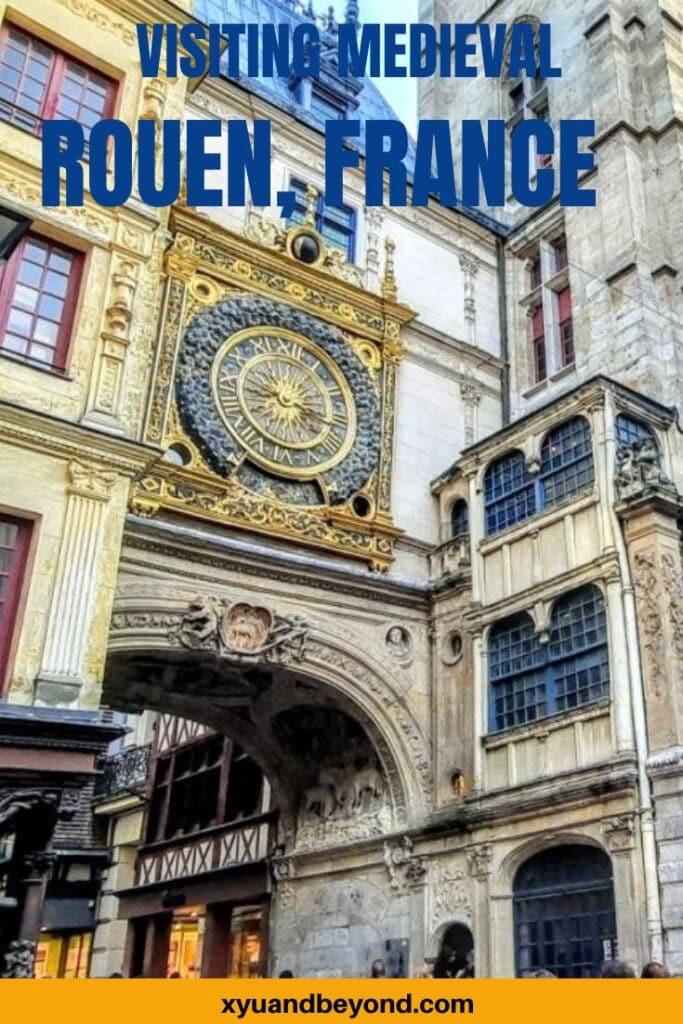A Guide to the best things to do in remarkable Rouen
Rouen France is an absolutely incredible city, vibrant, and historic and around every corner, there is architecture and history to revel in. This charming magical city captivated me from the moment I visited.
There is much to see in Northern France from its incredibly rugged coast to the famous Normandy beaches where the allied landings turned the tide of WWII. Lying on the banks of the Seine River Rouen is the capital of Normandy and a great base to explore the area. Rouen boasts the second largest number of listed buildings in France after Paris and a number of stunning churches, mostly constructed in Gothic style.
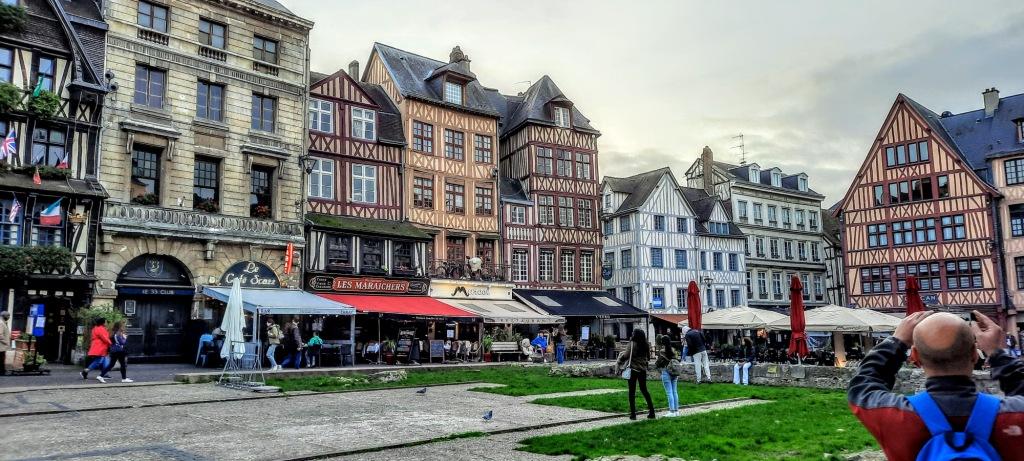
There’s Bayeux a beautiful old town with half-timbered houses and the gorgeous Bayeux Cathedral and the famous Bayeux Tapestry that depicts the Norman Invasion of Britain led by William the Conqueror in 1066.
About an hour and a half from Bayeux is one of the most visited places in France Mont Saint Michel and nearby you can visit Saint-Malo, Cancale, Granville and the incomparable Dinan. But visiting Rouen is a must-do for your bucket list. To walk in places where Joan of Arc did, admire the intricate and delicate tracery work on the Cathedral, and imagine yourself back in medieval France among the great Queens and Kings – not to mention enjoying some of the best food in France is a real treat.
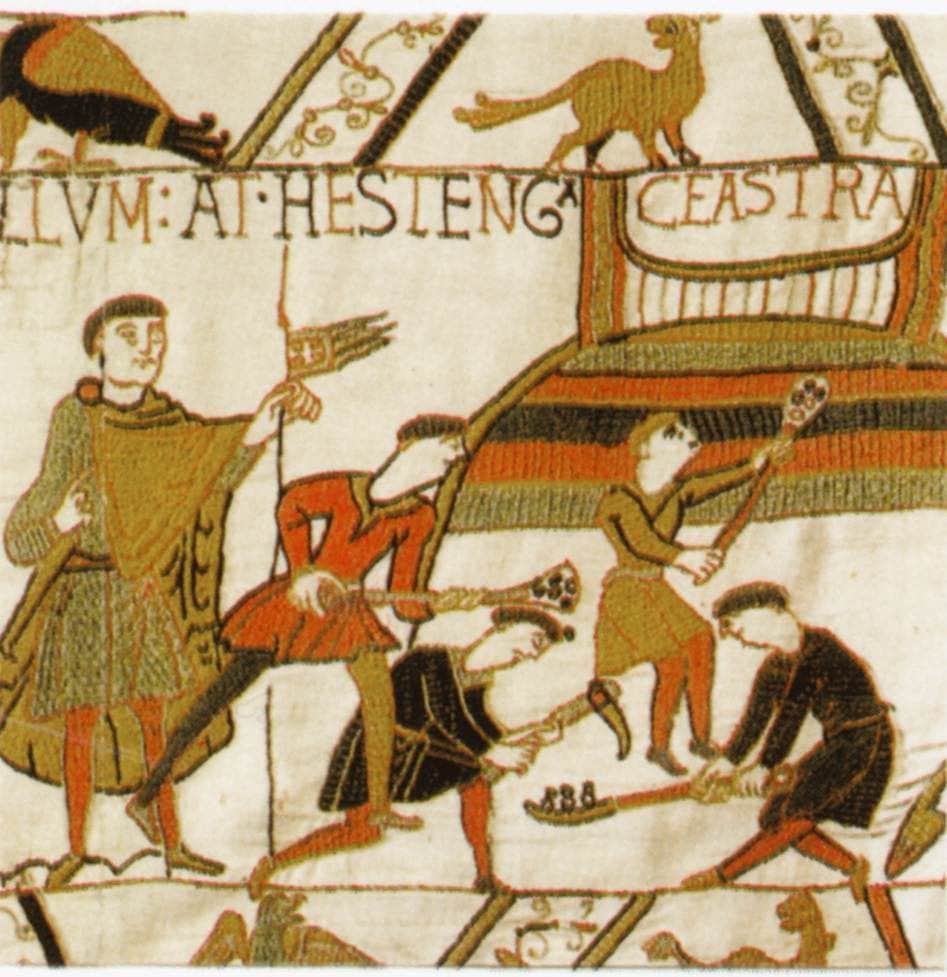
Rouen from Paris
Driving from Paris to Normandy is an easy trip. The city of Rouen is about an hour and a half’s drive from Paris
- A Guide to the best things to do in remarkable Rouen
- Rouen from Paris
- What is Rouen, France known for?
- A history of Rouen
- Why visit Rouen?
- The best time to visit Rouen?
- Rouen Attractions – what to do and see in Rouen France
- Admire the timber-framed houses of Rouen
- Place du Vieux-Marché
- Place de la Pucelle
- Historial Jeanne d’Arc
- Tour Jeanne d’Arc
- Rue St. Amand
- Saint-Ouen Abbey Church
- Palais de Justice
- Church of Saint-Maclou
- Ossuary of Saint-Maclou (Aître Saint-Maclou)
- Church of Saint Eloi
- The House of the Exchequer (Bureau des Finances)
- Musée des Beaux-Arts de Rouen
- Musee Secq Des Tournelles
- Gardens of Rouen
- Where to stay in Rouen
- Where to eat in Rouen
- Best Restaurant in Rouen
- Free things to do in Rouen
- Things to do around Rouen France
Xyuandbeyond is reader-supported. When you buy through links on our site, we may earn an affiliate commission. You can read my privacy policy here.
What is Rouen, France known for?
Rouen feels like you have stepped back into the past and is a museum that is lived in. There are beautiful half-timbered houses, gothic churches and cobbled streets, stunning lacework cathedrals and a surprise around every turn.
Rouen was the place of the martyrdom of Joan of Arc, the famous French hero who was captured by the British and then condemned to be burned in 1431, at the Place du Vieux Marché. Rouen is also nicknamed the “City of 100 bell towers” by the famous writer Victor Hugo.
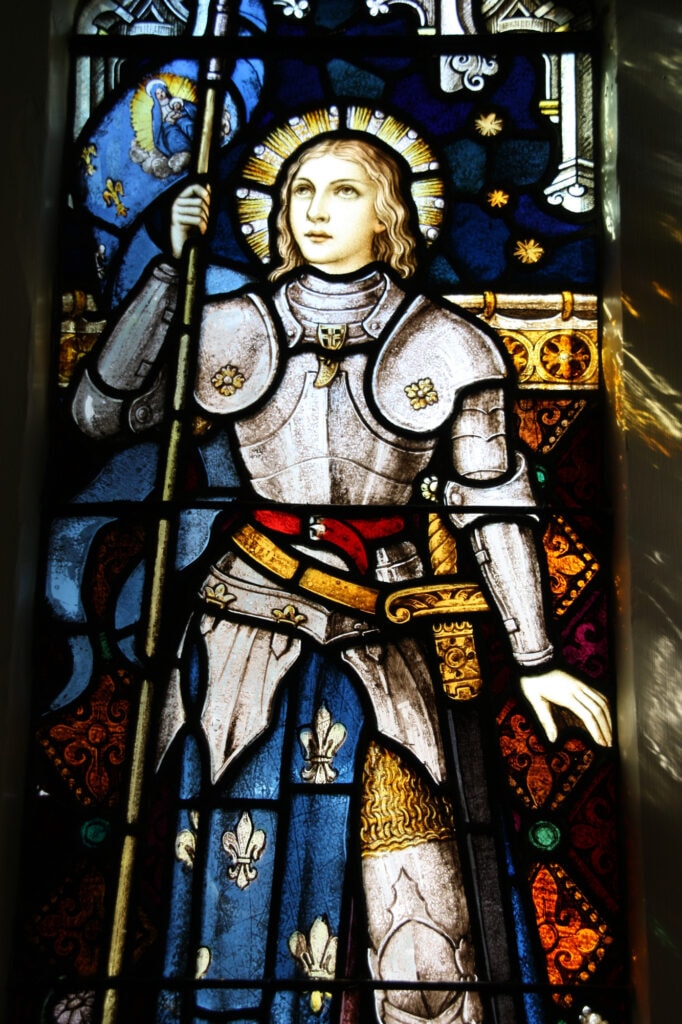
The city’s art scene has been the centre of attraction for painters for centuries. Monet the impressionist painted more than thirty views of Rouen Cathedral in 1892–93. Pissarro and Gauguin and less well-known figures including Angrand, Léon-Jules Lemaître, Charles Frechon and Joseph Delattre, who founded the Rouen school.
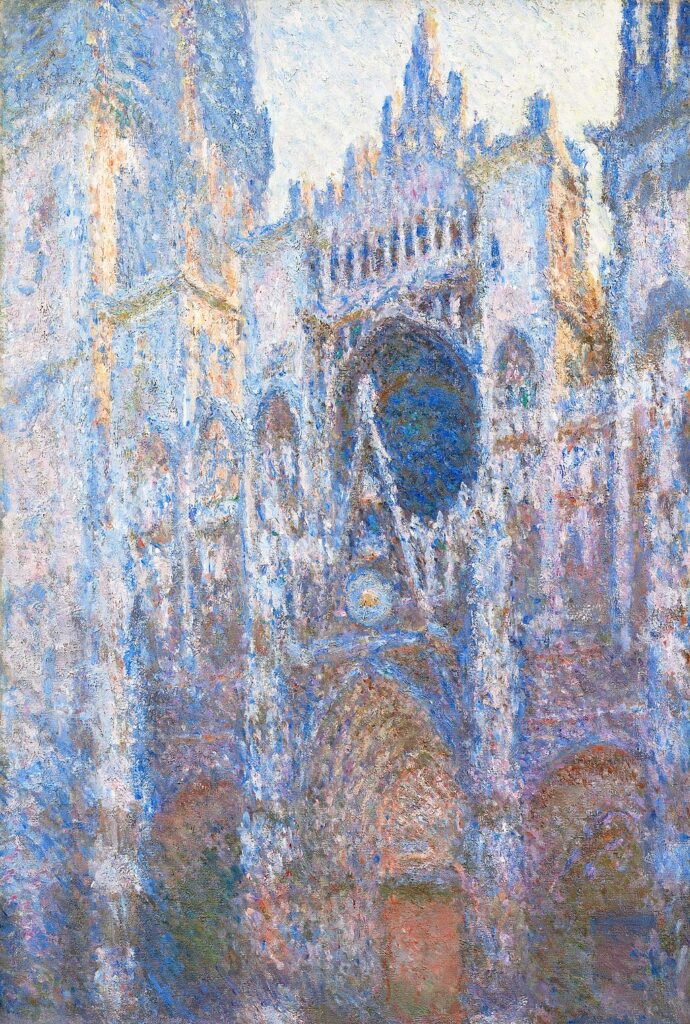
Rouen has the most listed historical buildings of any city in France. The town comprises about 2,000 half-timbered houses, of which half have been restored. The State has listed 227 houses as historical monuments. This makes Rouen one of the first six cities in France in terms of historic architectural richness, despite the destruction during the Second World War when a quarter of the houses in the town’s centre were burnt down.
Rouen is a foodie paradise and Rouen cuisine has even been distinguished by UNESCO, which crowns Rouen a “creative city” in the gastronomy category in 2021. It has become the first French city to obtain this label.
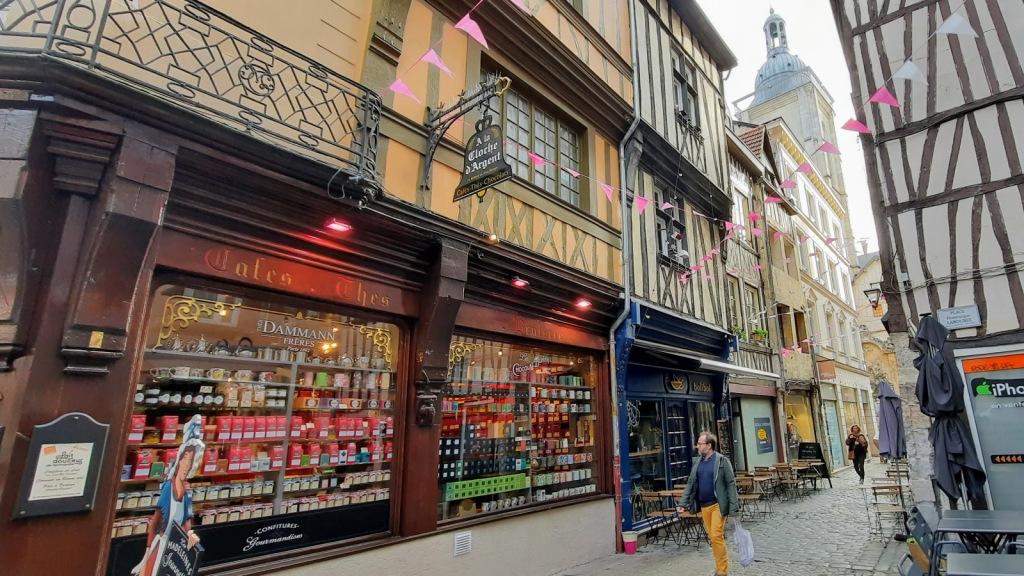
A history of Rouen
Rotomagus as Rouen was called by the Romans was an important trading centre and had an amphitheatre and thermae – a large Roman bath. Christianity came to Rouen with St. Mellon who became the first Bishop of Rouen.
The first sightings of Vikings on the Seine at Rouen were around 820 when 13 Viking ships reached Seine Bay, but they were quickly forced to return due to an unsuccessful raid.
21 years later, a large fleet of Viking ships sailed up the River Seine and took the city of Rouen by absolute surprise, they ransacked the city and burned it to the ground. In 887 the Viking warrior Rollo chose Rouen as his capital and in 911 was granted territory on both sides of the Seine river to protect Paris from attacks.
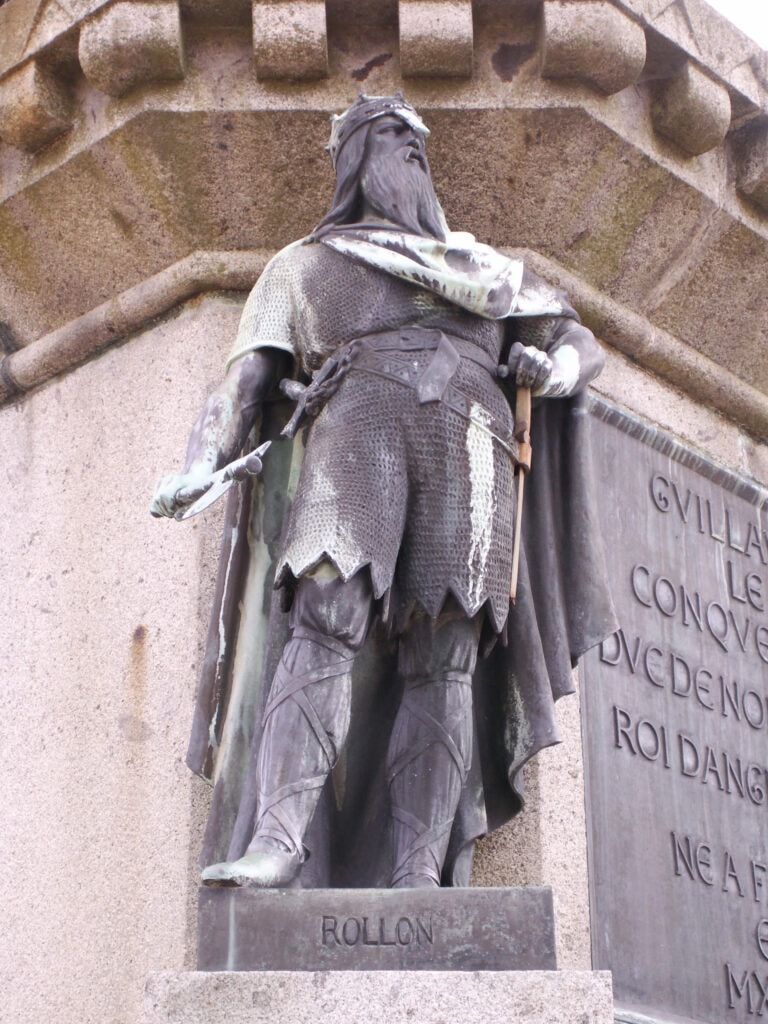
Rollo the Viking became Rollo the first Duke of Normandy. Another Viking who was converted to Christianity was Olaf II of Norway. Raised as a pagan he was baptized in Rouen in 1013 and ultimately became the King of Norway when he seized power in 1016.
He is credited for bringing Christianity to Norway and thanks to his religious work and the legendary miracles that surrounded his death he was canonized in 1031.
On the millennial anniversary of his baptism in 2014, the King of Norway – Harald V, strengthened the cultural ties between Norway and Normandy and gave a precious relic of Saint Olaf to the Rouen Cathedral.
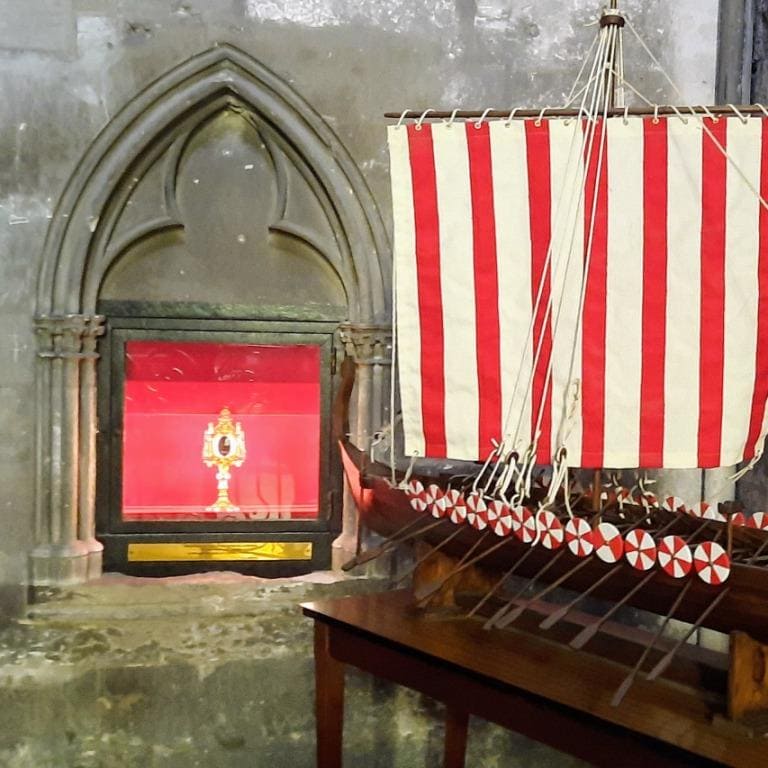
Decades later, the Vikings, now the ‘Normans’, set about reorganising their vast domain. The inheritance came down to William the Conqueror, who was born in Falaise in Normandy. William (c. AD 1027-1087) was the son of Robert I of Normandy and great-great-great-grandson of the Viking chieftain Rollo. William himself became Duke of Normandy in AD 1046.
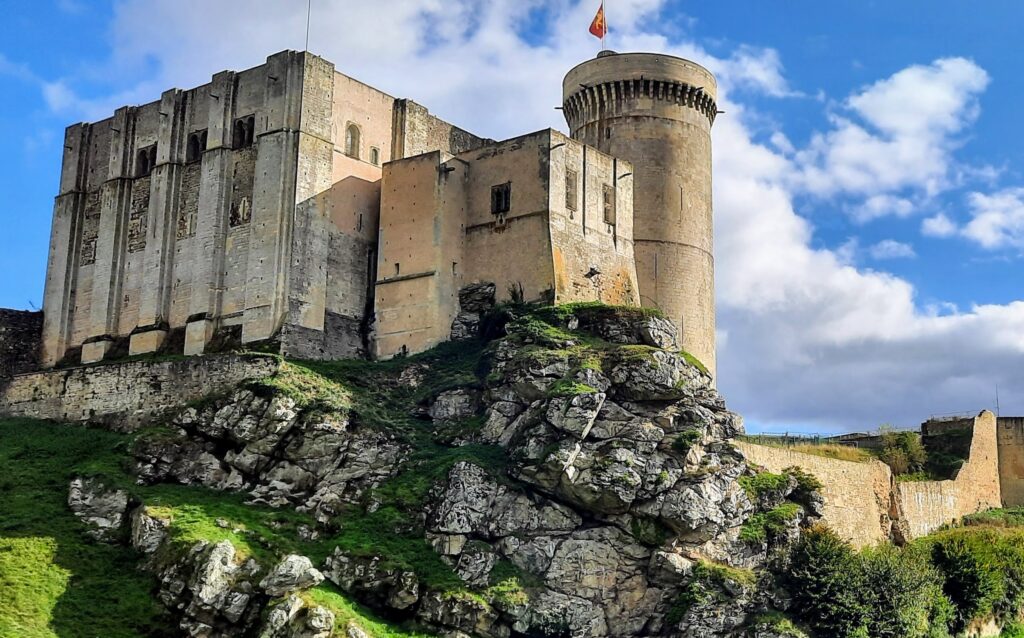
On Edward the Confessor the King of England’s death in AD 1066, William declared war on the newly crowned King Harald. The Bayeux Tapestry shows how William arrived in Southern England with a great fleet and almost 7000 men. On 14th October 1066, the Norman army met the English troops at the Battle of Hastings, where King Harold Godwinson was killed and William began his conquest of England.
William plundered and burned a number of towns in Southern England and took over control and began building his defensive castles across the land. For this reason, he was given the nickname “the Conqueror”. On Christmas Day of that same year, William was crowned king in Westminster Abbey in London. He remained on the throne until his death in AD 1087.
In 1204 the French captured Rouen, and the city prospered until the Hundred Years’ War (1337–1453), when, in 1419, it was taken by Henry V of England of the Plantagenets.
In 1430 St. Joan of Arc, the patron saint of France was imprisoned at Rouen in a tower that still stands and now bears her name. Tried and condemned for heresy, she was burned at the stake by the English in the city on the Place du Vieux-Marché in May 1431.
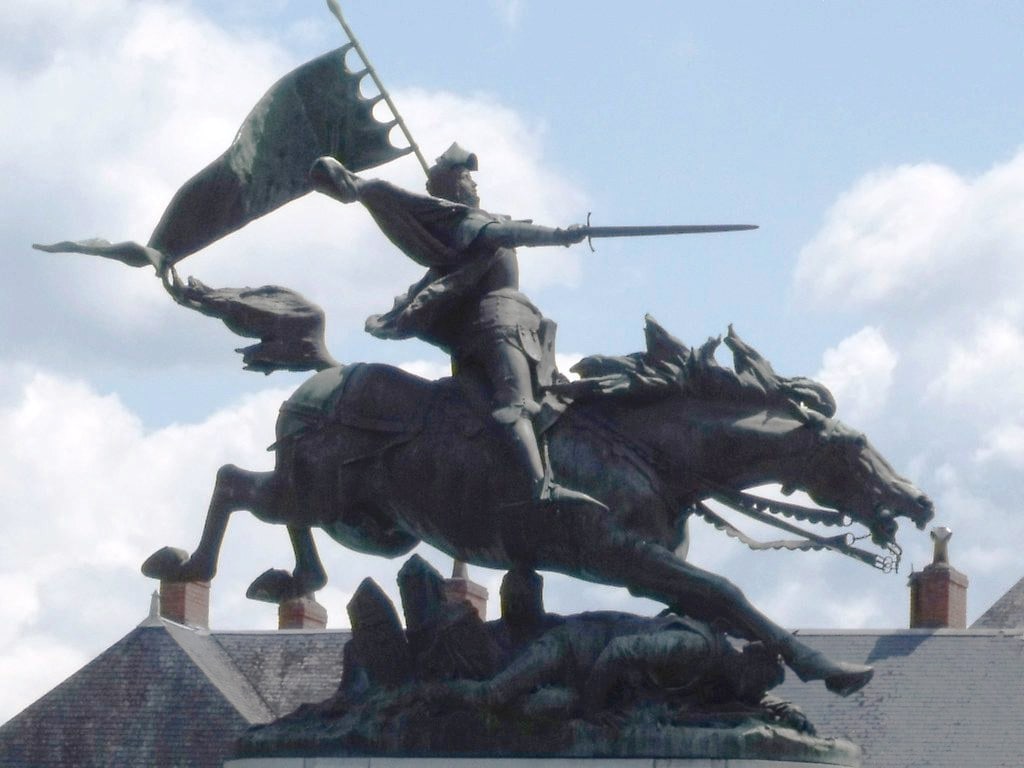
The city was recaptured by the French in 1449 and for the following century, it was one of the main cultural centres of France. Rouen suffered greatly during the Wars of Religion in the late 16th century and many emigrated after the Edict of Nantes took away the French Protestants’ civil and religious liberties.
The city went into decline after this emigration until the 19th century when the fabric trade brought new prosperity to the area. The craftsmen exported many stunning fabrics to England that were used by royalty.
During WWII and the German occupation, Rouen was heavily damaged by bombing and much of the medieval architecture was damaged. The French spent many years rebuilding and reconstructing the centre of the city.
Why visit Rouen?
The top things to see in Rouen is to visit the places that Rouen is famous for. These include the martyrdom of Saint Joan who was burned at the stake here and its fine Cathedral in which you can see the tombs of William the conqueror, Rollo the Viking, and Richard the Lionheart whose heart was buried here.
The best reason to visit Rouen is to simply wander the cobbled streets and soak in the incredibly historic atmosphere. There’s the clock tower, the impressive modern church dedicated to Saint Joan, Rouen’s Cathedral, hundreds of half-timbered houses and many fascinating medieval historic sites.
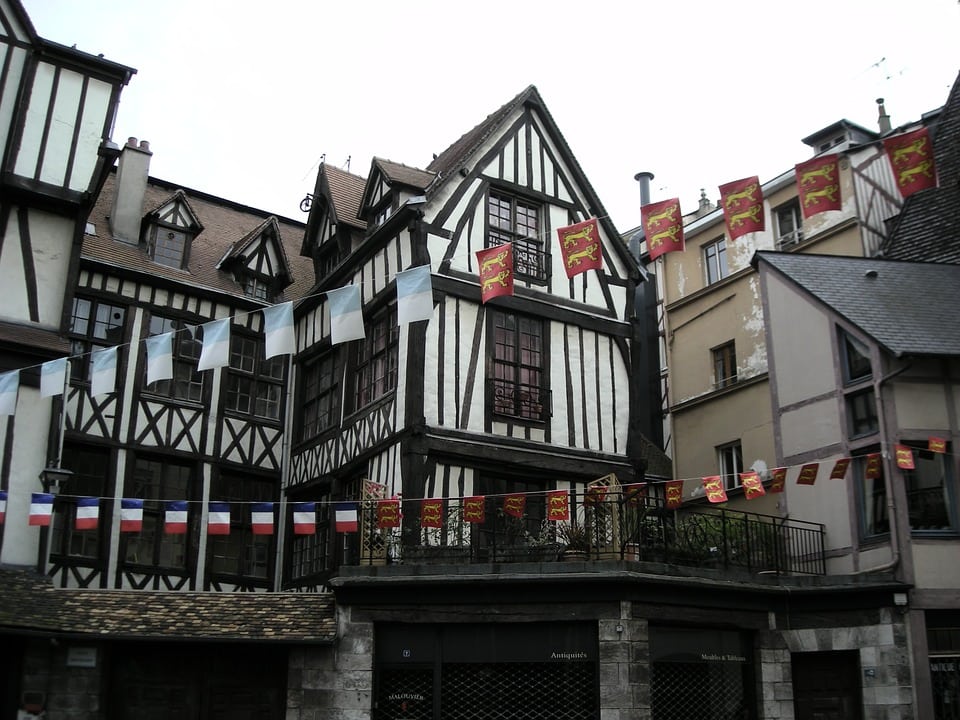
The best time to visit Rouen?
The best times to visit Rouen is in either spring or fall when the crowds are at their quietest. During the summer months, the city is packed with tourists and it makes it difficult to see many of the interesting sites in Rouen.
One of the best times to visit Rouen is to see the fabulous spectacle of the light display on the Rouen cathedral – this takes place after the sun sets from June to September.
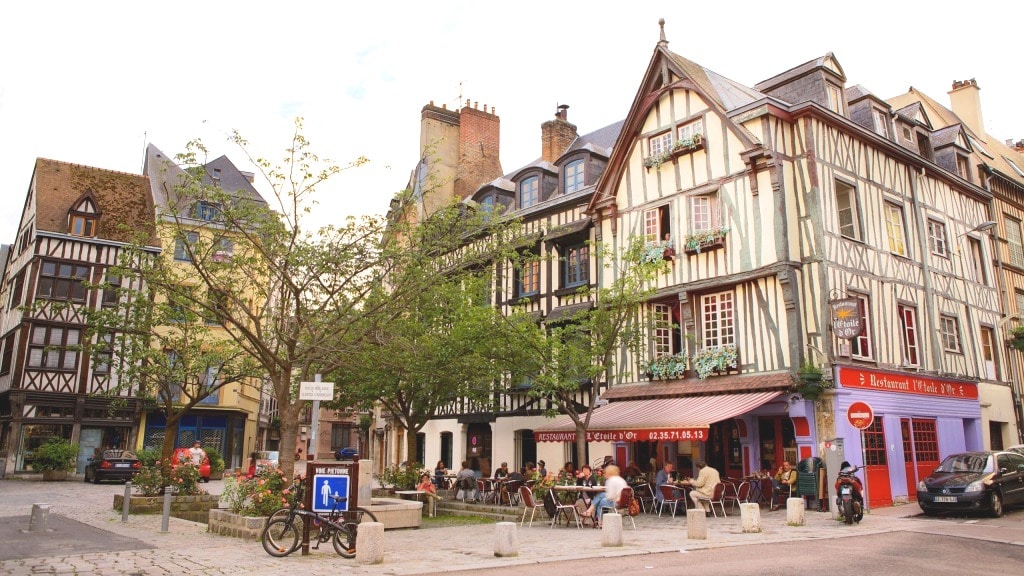
Rouen Attractions – what to do and see in Rouen France
Visiting Rouen is like a step back in time and at every turn, you will be snapping photos and standing in awe at the site of gothic tracery on ancient churches or admiring tiny peaceful gardens.
Rouen is truly a photographer’s paradise and a history buff’s perfect city. These are all the best things to do in Rouen.
Rouen Cathedral
One of the finest examples of Gothic architecture is the Rouen Cathedral which is the final resting place of Richard the Lionheart’s heart – as was common during the middle ages his body was buried at Fontevraud Cathedral along with his mother Eleanor of Aquitaine.
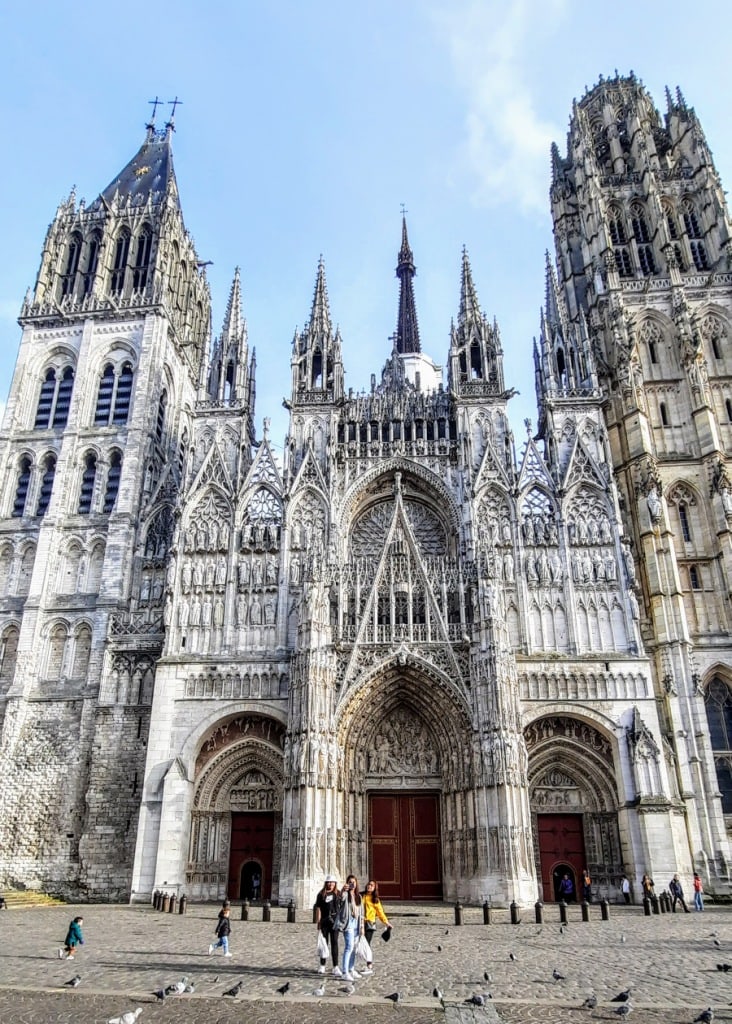
Others who lie in the cathedral are Rollo the Viking, William Longsword, the son of Rollo (died 942); Henry the Young King (died 1183), Empress Matilda or Maude.
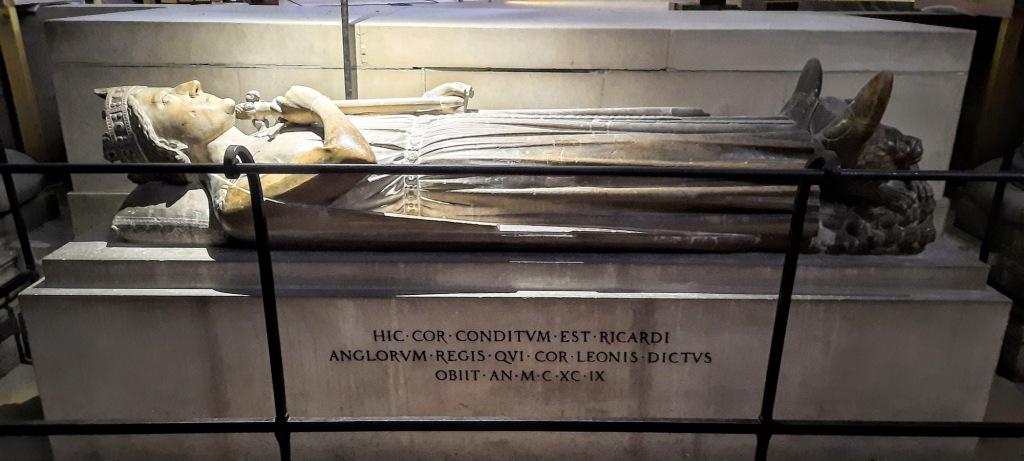
The remains of the four Dukes of Normandy are the tombs of Rollo, the Viking and the first Duke of Normandy; William Longsword, the son of Rollo (died 942); Henry the Young King (died 1183); and a tomb with the heart of Richard the Lion-Hearted, Duke of Normandy and King of England (died 1199).
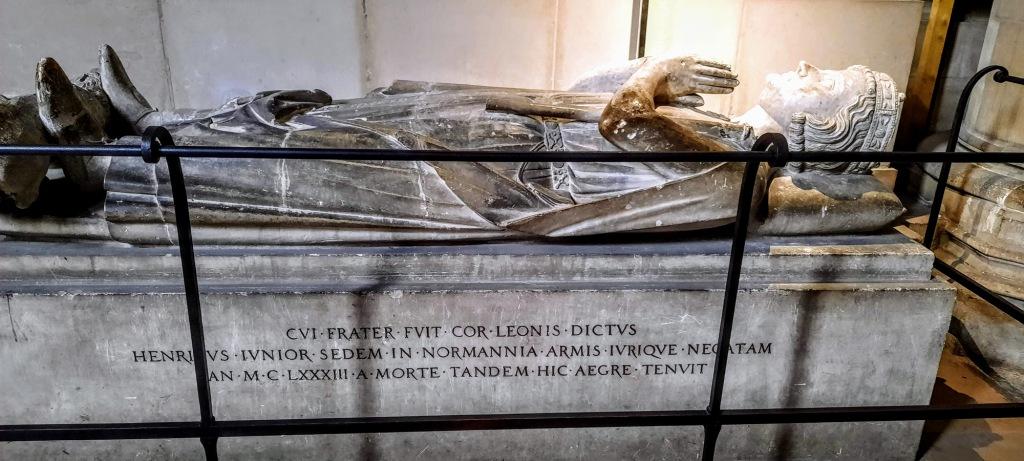
The original tomb of Rollo was destroyed during the bombing of 1944 and was replaced by a copy of the tomb of Henry the Young King made in the 19th century.
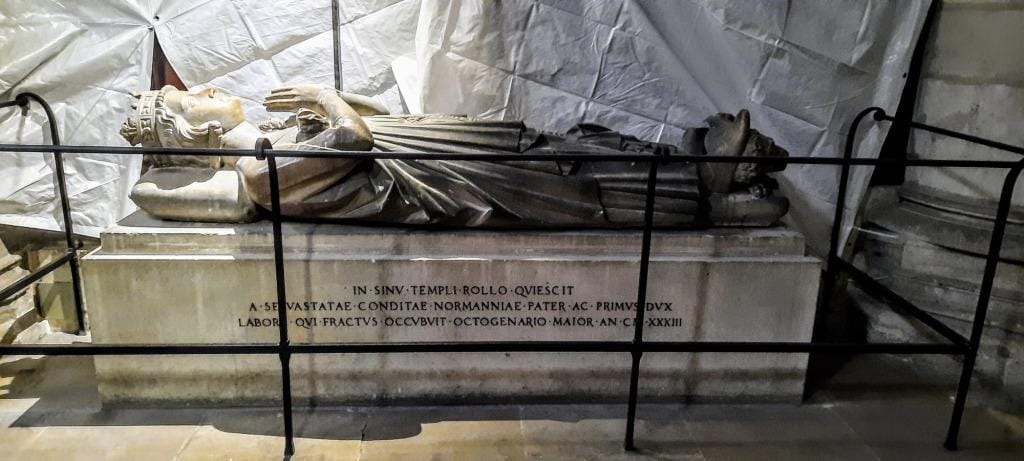
Matilda was a skilled diplomat and negotiated complex peace treaties with powerful people such as the Pope, years before her efforts to be crowned Queen of England. Matilda was the first English woman to be crowned Holy Roman Empress and ruled as regent of Italy, along with English provinces in modern France.
Maude was one of the claimants to the English throne during the civil war known as the Anarchy. The daughter of King Henry I Matilda was never formally declared Queen of England and was instead titled “Lady of the English” after attempting to reclaim her crown from Stephen (unsuccessfully) during what became known as the time that Christ and his saints slept or the period called the Anarchy.
Matilda returned to Normandy, now in the hands of her husband, in 1148, leaving her eldest son to continue the campaign in England; he eventually succeeded to the throne as Henry II in 1154, forming the Angevin Empire. She settled her court near Rouen and for the rest of her life concerned herself with the administration of Normandy.
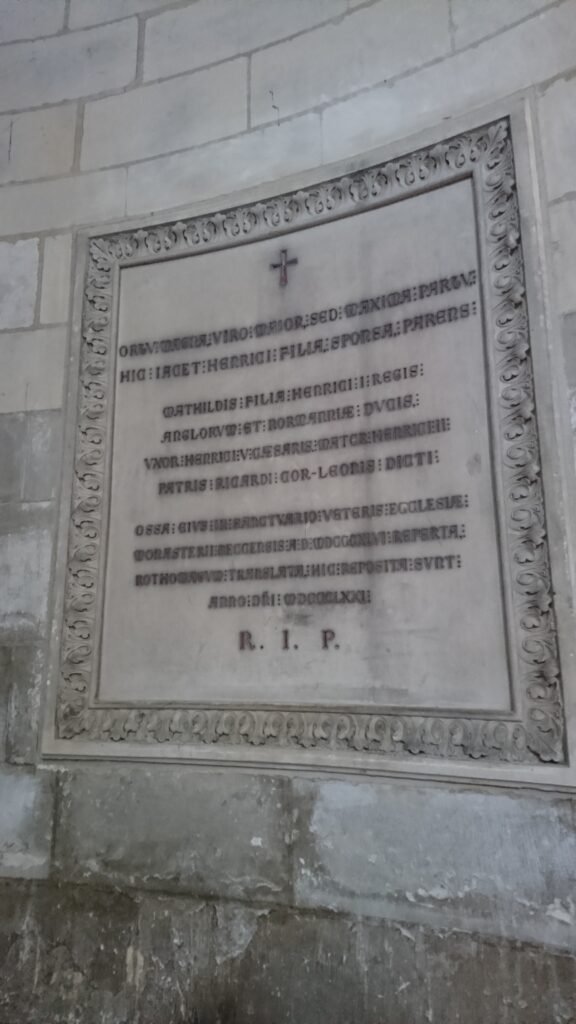
Matilda died on 10 September 1167 in Rouen, and her remaining wealth was buried under the high altar at the abbey of Bec-Hellouin her tomb’s epitaph says “Great by birth, greater by marriage, greatest in her offspring: here lies Matilda, the daughter, wife, and mother of Henry”.
This tomb was damaged in a fire in 1263 and later restored in 1282, before finally being destroyed by an English army in 1421. After Napoleon destroyed the church her remains were reburied at Rouen Cathedral.
Another interesting tomb in the chapel is that of Louis and Pierre de Brézé, made between 1536 and 1541 in a purely Renaissance style. Louis was the husband of the infamous Diane de Poitiers, Mistress of King Henri II of France and lived in the stunning Chateau Chenonceau which was given to her by the King.
Diane commissioned a monument of Louis riding his horse triumphant in full armour and at the bottom of the monument as a corpse, almost nude. Diane is depicted next to his corpse, kneeling.

The Tour de Beurre or the Butter Tower on the west side of the church was nicknamed so due to the fact that the funds to pay for it were collected from the congregation who paid a penance for eating butter during Lent.
A visit to the Cathedral is free and you can admire the incredible stained glass windows, the stunning organ and the effigies decorating the tombs and memorials.
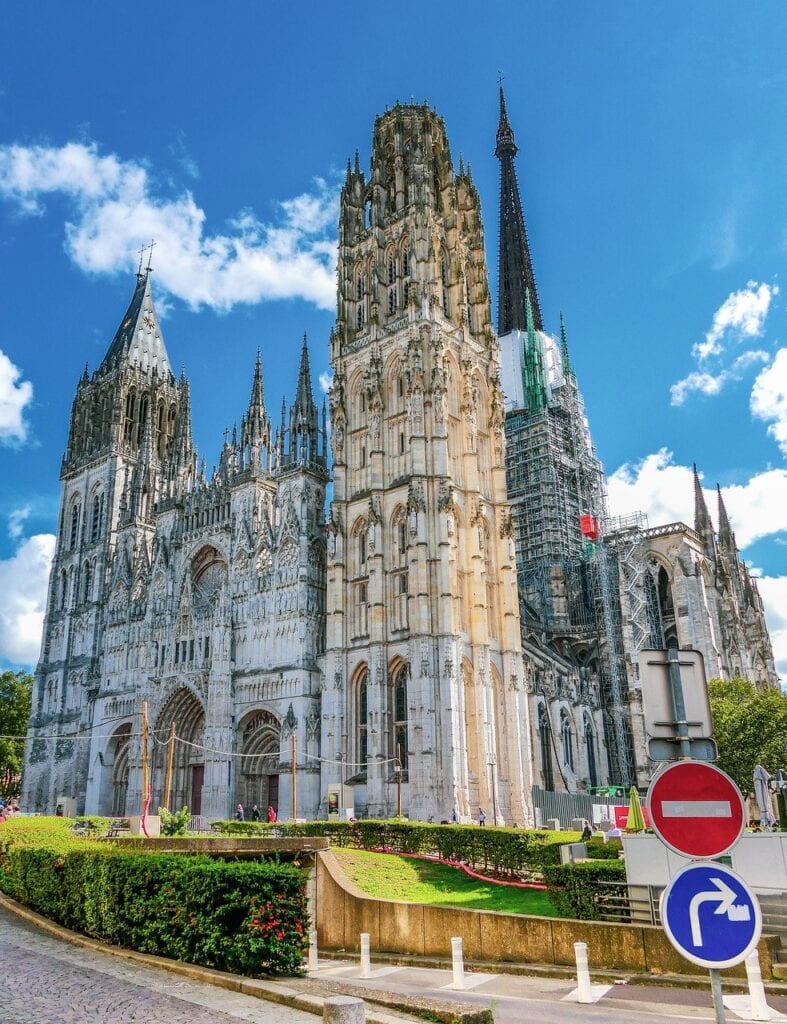
In the summer months, a brilliant Son et Lumiere show projects the history of Rouen against the west face of the City’s Notre Dame Cathedral.
Visit the Gros Horloge of Rouen
The Rue du Gros Horloge is a one of Rouen’s main shopping streets, where high-street stores sit in the half-timbered houses, some of which still show damage from WWII. The fourteenth-century Gros Horloge (Great Clock) is magnificent it sits in the centre of the city in Rouen’s main shopping area, on the Rue du Gros Horloge straight down from the Rouen Cathedral.
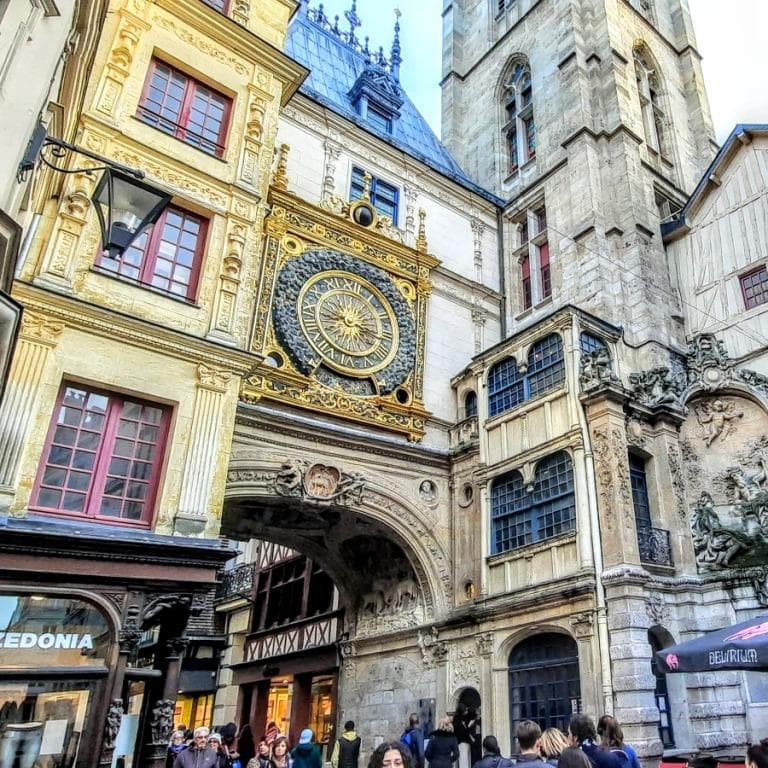
The Gros Horloge is an astronomical clock and has one of the oldest working mechanisms in France. In the 1920’s it was electrified. The clock face is set within a tower which is elaborately carved with images of shepherds and their sheep which symbolize the powerful wool industry that brought Rouen so much wealth.
Above the dial, a globe indicates the phases of the moon. The Easter lamb, represented in the centre of the arcade, symbolizes the arms of the city. Finally, a Louis XV fountain completes the ensemble and celebrates the love of the river god, Alpheus, and the nymph Arethusa.
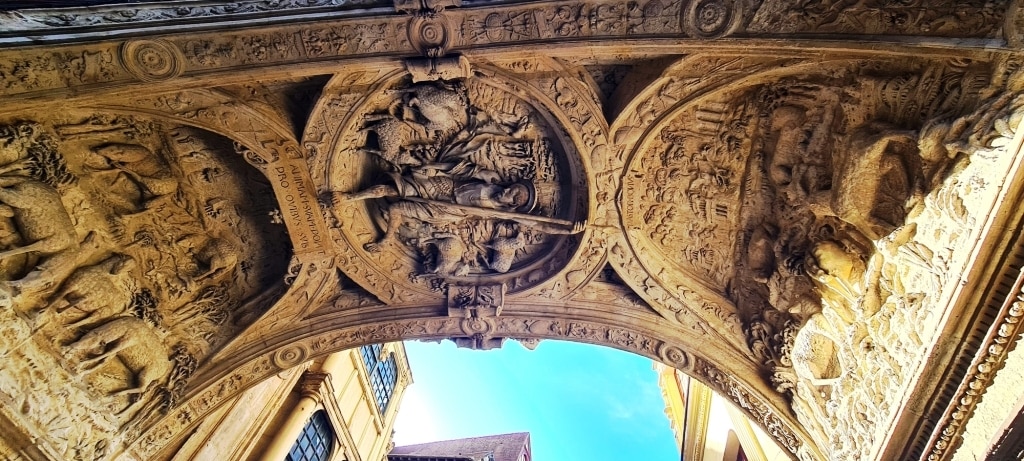
You can tour the tower for €7.20 and see behind the scenes of this historic monument where you can visit the dial room and the belfry.
Admire the timber-framed houses of Rouen
Any Rouen visit should just include wandering the small streets of the city. Since Rouen is dominantly a pedestrian zone walking around the cobblestone streets and admiring the incredible buildings is mandatory. Off the Rue du Gros Horloge, you will find small narrow streets that lead into bigger squares with more architectural discoveries to be made.
The incredible half-timbered buildings sitting at various loopy angles make it a joy to simply wander the small streets of this iconic city.
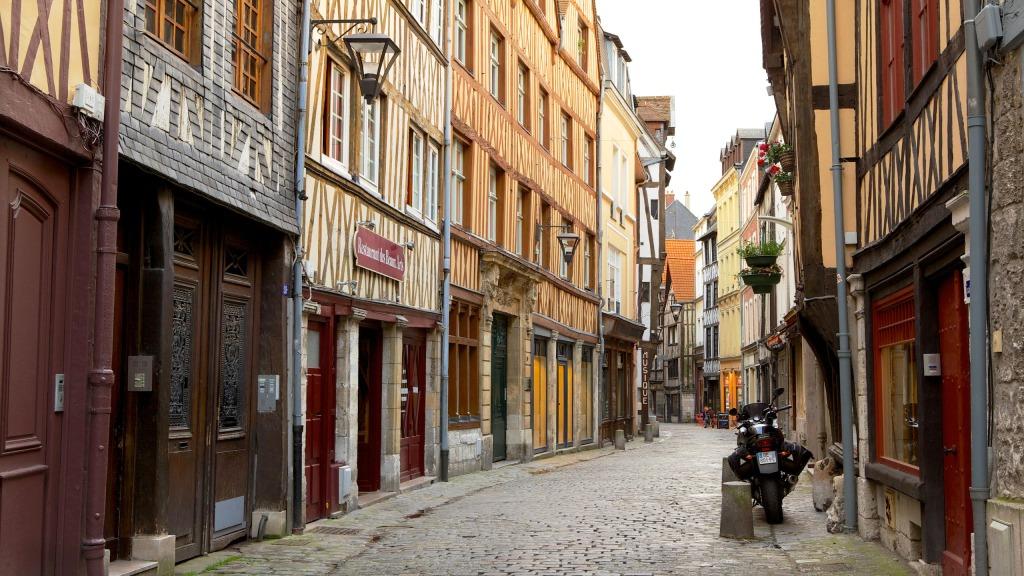
Place du Vieux-Marché
One of the best things to see and do in Rouen is walk the Place du Vieux Marché (in English is the Old Market Square) and it is the main historic and original market square of Rouen and when you come upon it from the rue du Gros Horloge the modern Church of Saint Joan of Arc will astound you with its dragon-like appearance.
It was in this square, during the Hundred Years’ War, that Joan of Arc was burned alive on May 30, 1431. At that time in history, the Place was much smaller and the Saint-Sauveur Church was the dominant building. There was a smaller church in the Place called Saint-Michel and a large market hall. This was the place of executions in Rouen.
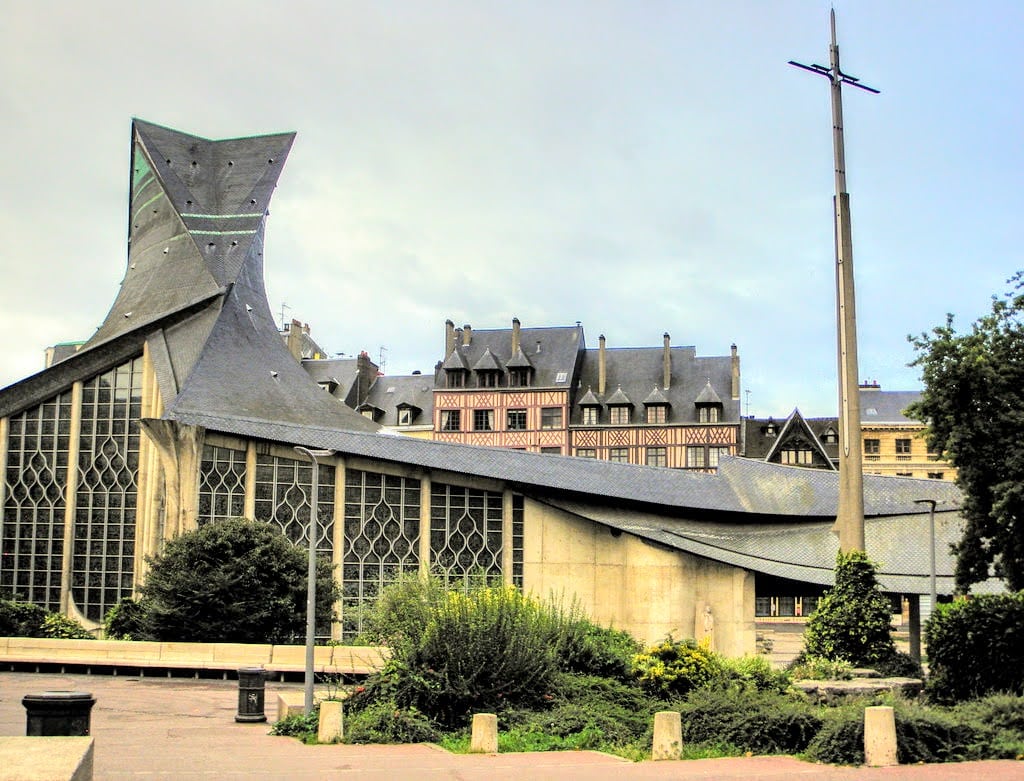
A cross was erected next to the site of the stake where Saint Joan was burned and it is a national monument. In July 1920 a law was introduced to raise the cross and create a national feast of Joan of Arc.
Saint Sauveur Church was destroyed in 1793 and the Sainte-Jeanne-d’Arc was built on the ruins in 1979. The modern building incorporates the stunning stained glass windows from the old Saint Vincent Church once located at the end of the rue Jeanne-d’Arc that was destroyed during the bombing in 1945.
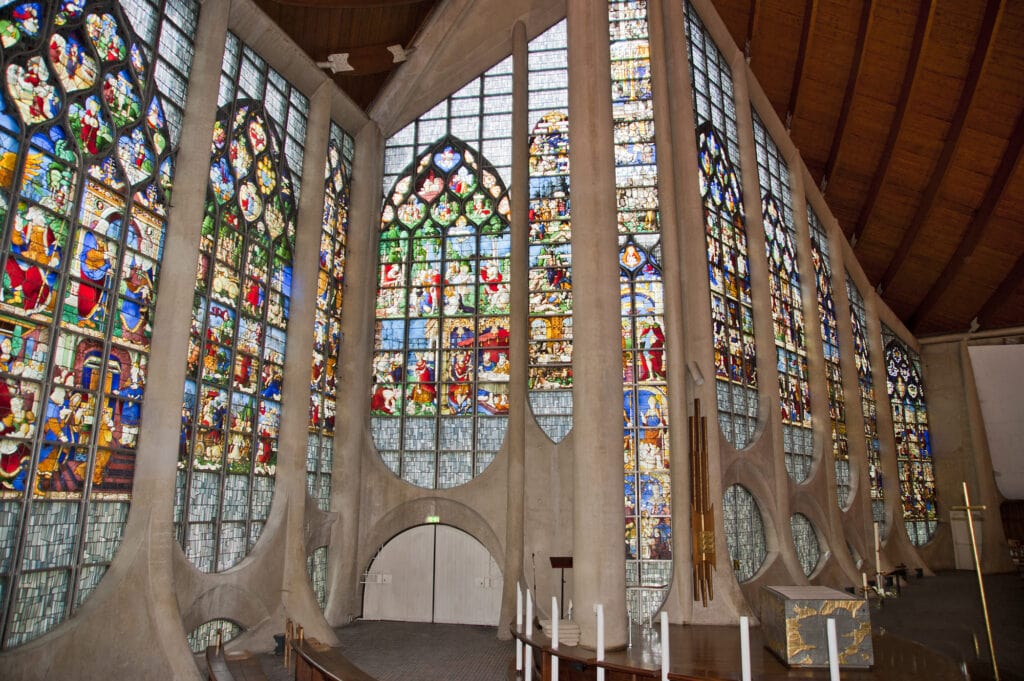
The building incorporates a small market hall with select food and flower shops and hosts the Rouen market at the weekend.
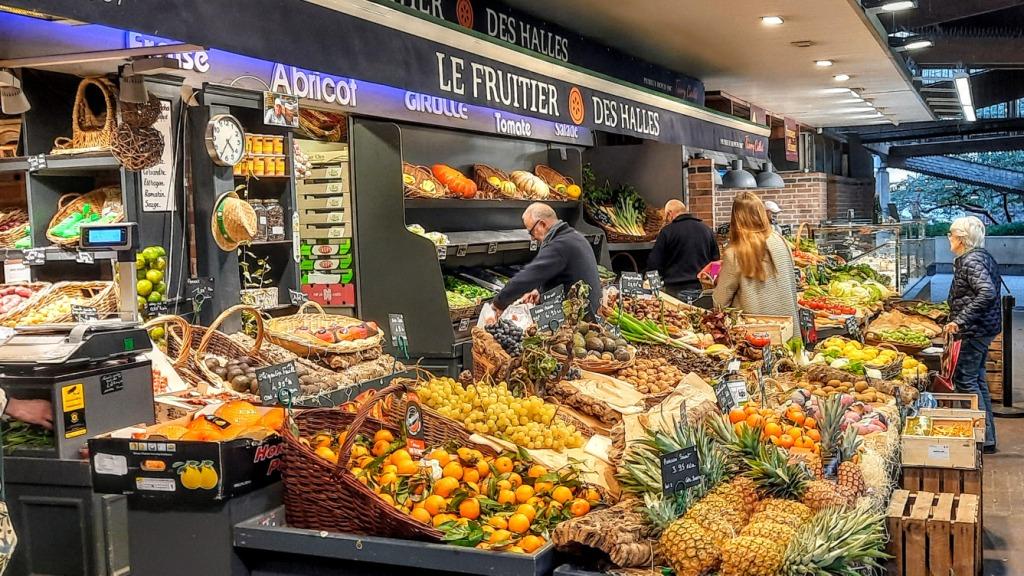
Today the Place is also the centrepiece of a restaurant and cafe area, which includes La Couronne, best known as the restaurant where American TV chef Julia Child enjoyed her first meal in France—sole meunière—and was introduced to French cuisine.
The place, as Joan of Arc saw it, did not look like what it is today. The square was smaller and its space was occupied by the Saint-Sauveur church, the Saint-Michel church and by a large market hall. It was also the usual place for executions.
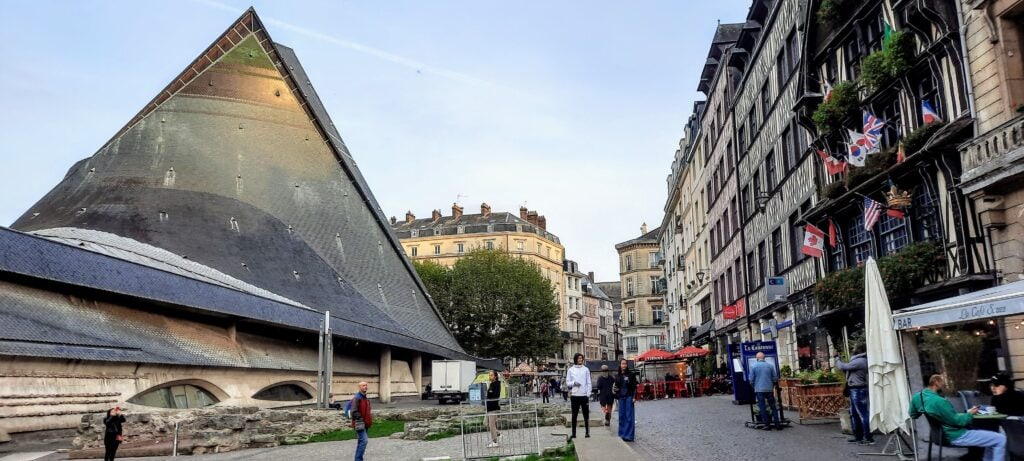
In the middle of the square, the remains of the old Saint-Sauveur church have been unearthed. It is in this modest parish church that Pierre Corneille was baptized, his birthplace, rue de la Pie, now transformed into a museum located nearby.
Place de la Pucelle
Just off the rue du Gros-Horloge is the Place de la Pucelle where there was a fountain at the entrance of the square which was built in 1530 and dedicated to Joan of Arc which led many to believe this was where she was executed. The fountain was destroyed in 1944 by the bombing of Rouen.
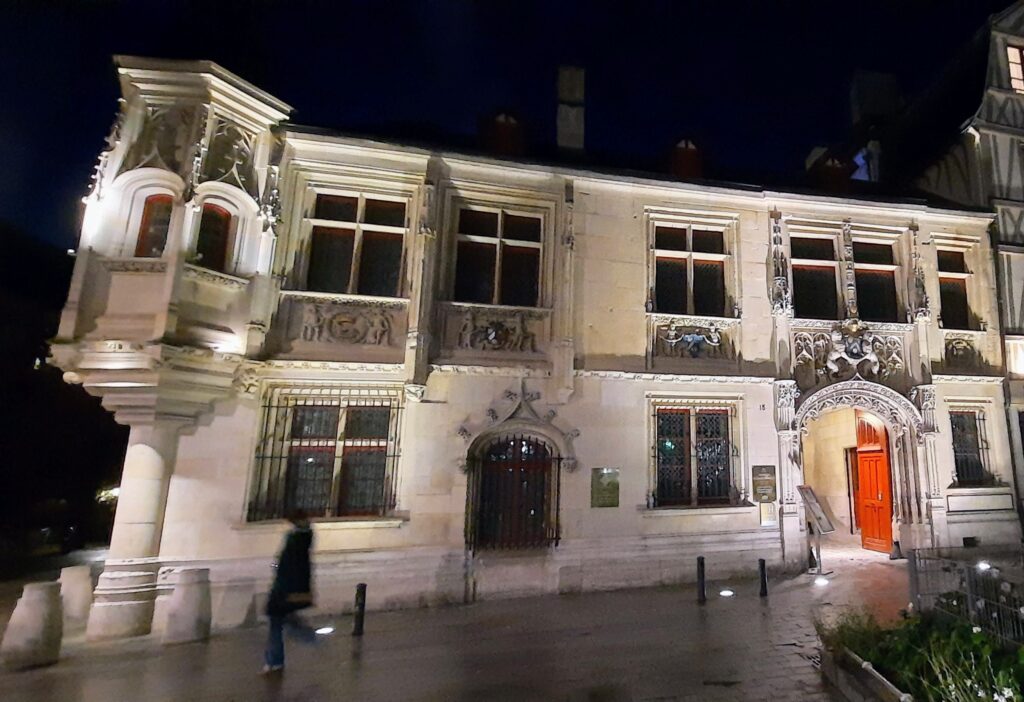
Here you will see the incredible Hotel de Bourgtheroulde which was once the residence of Guillaume II le Roux, Lord Bourgetheroude and member of the Exchequer of Normandy. Although the building is considered Flamboyant Gothic there are some Renaissance influences visible within the courtyard.
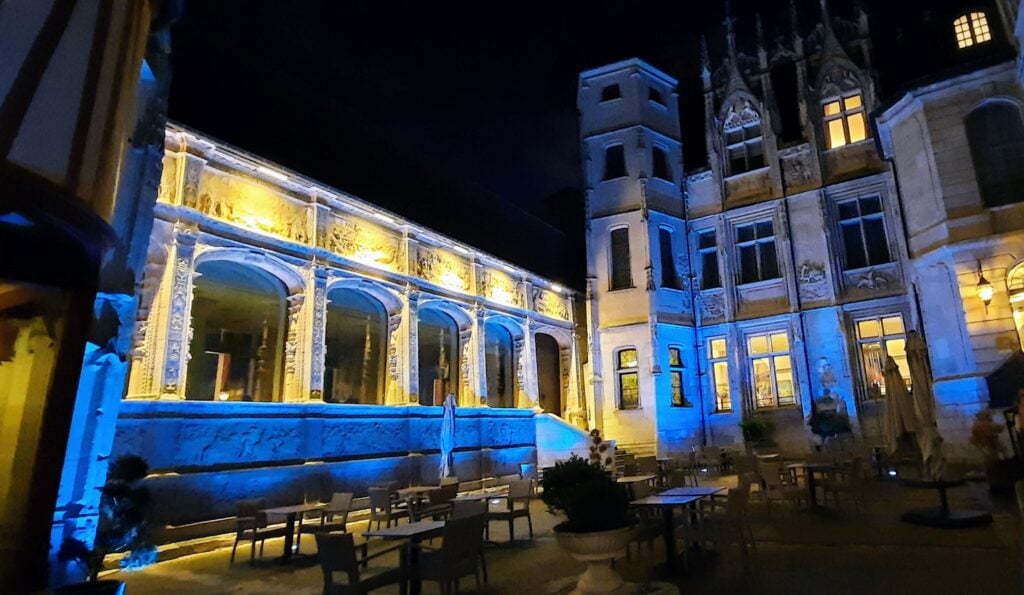
The War destroyed the building but it was reconstructed completely after the war finished. After the war it became a bank and then a 5-star hotel in 2010.
Historial Jeanne d’Arc
There are several places to visit in Rouen that are dedicated to Joan of Arc. The Historial Jeanne d’Arc is housed at the Archdiocese of Rouen, on the rue de Romain, this 5 story museum is dedicated to Joan of Arc. The legendary figure and young French heroine wa born in 1412 to poor farmers and died at the take when she was 19. Joan said I am not afraid… I was born to do this” and “I was in my thirteenth year when I heard a voice from God to help me govern my conduct. And the first time I was very much afraid.”
Often nicknamed ‘La Pucelle d’Orléans’ (the maid of Orleans), Joan of Arc was born during the Hundred Year War, a fierce struggle between the French and the English over who would be the next heir to the French crown.

Aged just 18, she led a victory against the English in Orléans, hence her nickname. However, by the time she was 19, Joan of Arc was captured in Rouen by the English, who by this point was in control of the city. She was tried for heresy and put to death, burned at the stake in the heart of Rouen or so it is alleged.
Tour Jeanne d’Arc
A great place to visit if you want to see where Joan of Arc was kept is the Joan of Arc tower is a Classified Historic Monument and is the last remaining piece of a once impressive Rouen Castle, the tower was built in 1204 by Philippe Auguste. Today, the building is home to an escape room game. The tower (known in French as ‘Tour Jeanne d’Arc‘) is the only part that remains of the Castle of Rouen built by Philip Augustus.
Joan of Arc was brought to the castle by the English to face trial and was kept in the dungeon where she was threatened with torture.
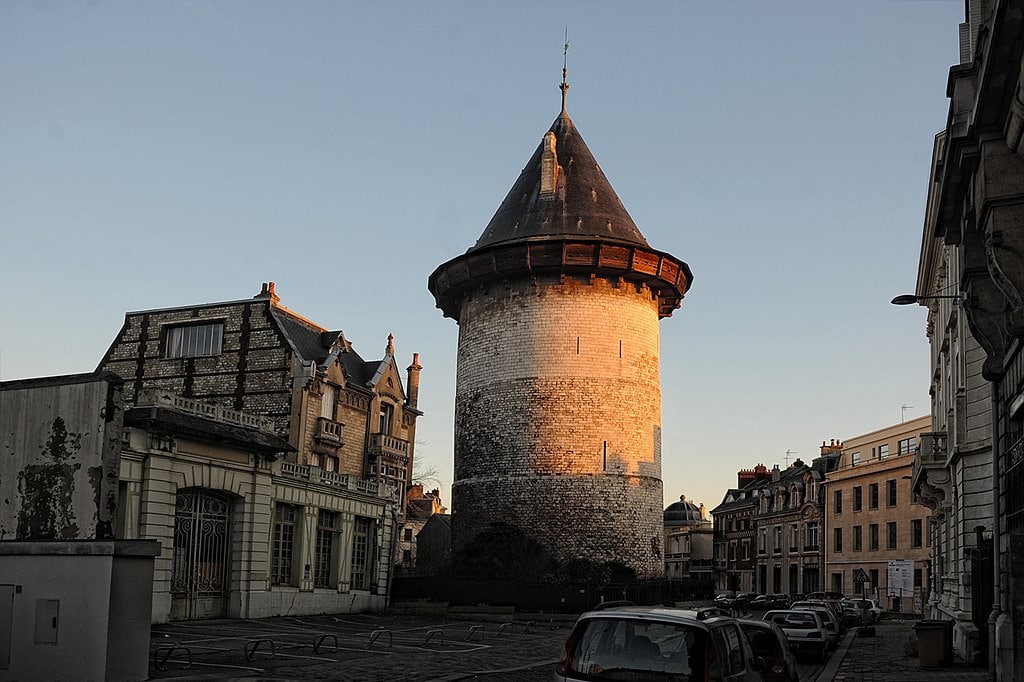
Joan of Arc was brought inside the castle when she was taken prisoner on the 24th of May 1430 and brought to face trial before she was taken to be burnt at the stake.
During the Second World War, the tower was turned into a bunker by the Germans. The remains of the 13th-century castle of Philipe Auguste are also accessible on a free or guided tour on dedicated slots.
Rue St. Amand
On this street, there was an Abbey dedicated to Saint Amand The abbey was founded around 1042 by Gosselin d’Arques, viscount of Rouen and by his wife Emmeline. The Abbey was founded on some Roman ruins and was a Benedictine Abbey for women.
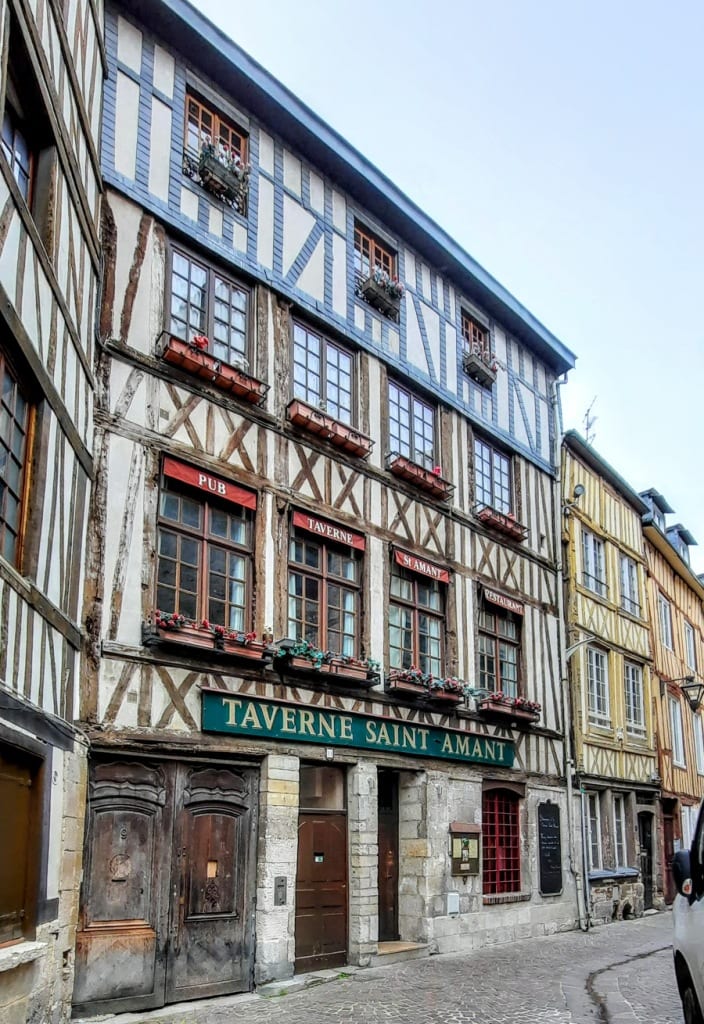
Sadly the Abbey was completely razed but remains of the Gallo-Roman theatre are preserved underneath the existing buildings.
Saint-Ouen Abbey Church
Saint Ouen Abbey Church’s construction began in the early 14th century and much of the building was delayed by the Hundred Year’s wars. The church stands next to the old abbey gardens, now part of City Hall and is a masterpiece of flamboyant Gothic architecture.
The Church is built is what is known as the Rayonnant style, a French building style that represents the height of Gothic architecture. The Rayonnant style concentrated on the decoration of the building with lace work pinnacles, moulding and window traceries.
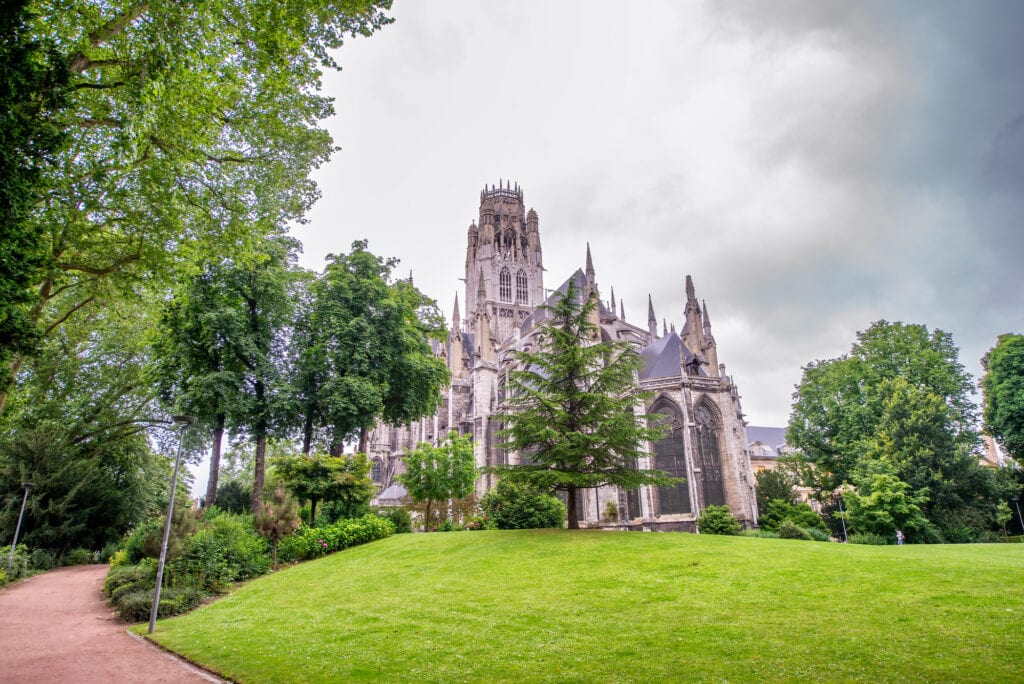
The church has two spire towers above its western façade and an 82-metre lantern tower nicknamed the “Crown of Normandy”. It also has the finest collection of 14th-century stained glass windows in France. The 1890 organ by Cavaillé-Coll is considered one of the most beautiful in the world, with 5,000 pipes and 4 keyboards and is the largest in France outside Paris.
Palais de Justice
Located beside the Rouen Cathedral you will find the Palais de Justice a historic monument and now the main courts of the region. This Gothic site once housed the seat of the Parliament of Normandy. Only the west wing on the left of the facade is truly Gothic. This oldest part of the building, erected in the 15th century is called New Market Hall (Palais du Neuf Marché).
The central part of the building is a mix of Gothic and Renaissance styles. The right-wing is neo-Gothic from the 19th century which replaced a Classical style facade.
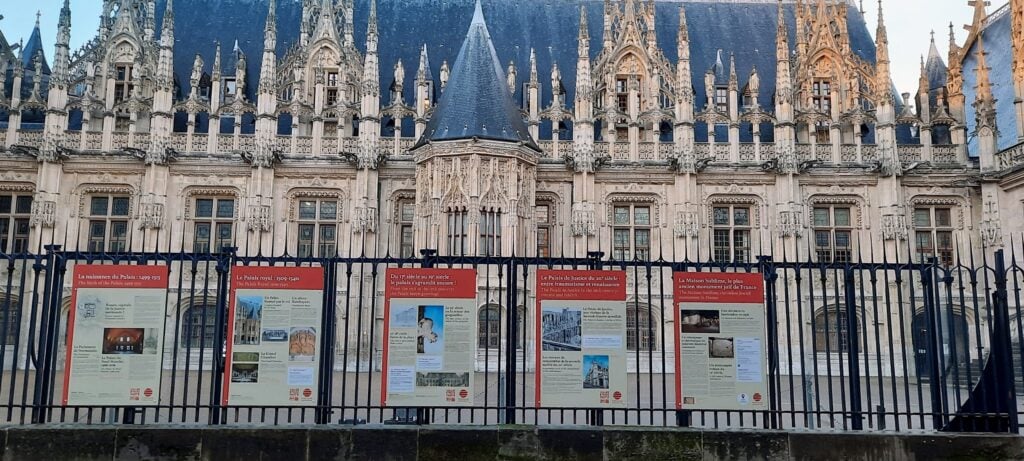
In 1976 a discovery was made of a Jewish monument under the Palais courtyard that dates back to the 12th century. The entrance is named in Hebrew and translates as ’Sublime Abode.’ Even now, archaeologists are not certain whether it was a college or a synagogue or even the residence of a wealthy merchant or trader.
Church of Saint-Maclou
Dedicated to the Breton Saint-Malo this intricately decorated gothic church is stunningly beautiful. There are 5 porches with incredible carved wooden doors that date back to the Renaissance period. Inside there is a Flamboyant Gothic staircase and a Renaissance organ alongside Baroque confessionals from the 18th century.
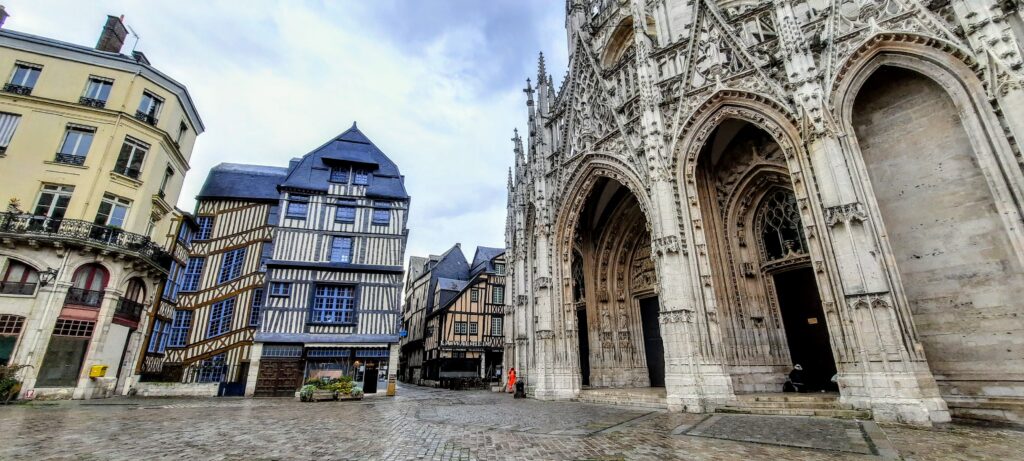
Badly damaged after the War temporary repairs were made to the Church which has now been finished. The church’s 5 bells called Marie, Adrienne, Adele, Josephine and Leontine are now sheltered and protected by the reconstructed lantern tower.
Ossuary of Saint-Maclou (Aître Saint-Maclou)
Across the road from the church, you will spot a medieval alleyway take a walk down to one of the most interesting landmarks in Rouen the Aître Saint-Maclou.
The Ossuary dates back to the 1300s when the Great Plague raged across the European continent. Saint Maclou lost three-quarters of its Parish to the plague in 1348. The Ossuary was where the victims were buried.
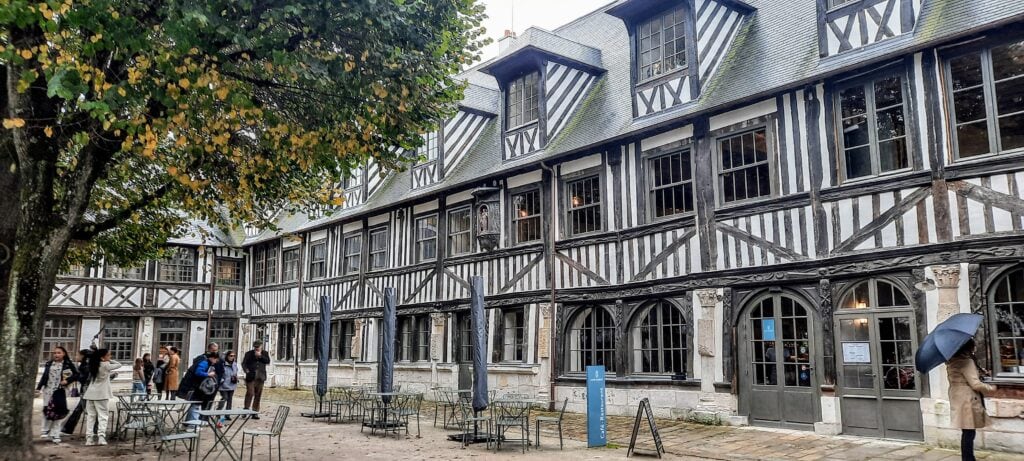
The victims were buried in a central grave in the middle of the courtyard. From 1526 to 1533 there were so many burials in the yard that three galleries were built above to house the bones.
The carvings around the lintels and doors surrounding the central courtyard are of skulls, bones, picks, axes and shovels all icons of burial. Near the front door, a skeleton of a cat was found probably believed to be able to ward off bad luck.
Church of Saint Eloi
On the Place Martin Luther King, not far from the Place de la Pucelle, is the 16th-century Gothic church of Saint Éloi. After the Revolution, the church was preserved but closed in 1791.
In 1793 it became a factory producing lead shot but Bonaparte assigned the Church to the Reformed movement in 1803 as a place of worship for Protestants – the Huguenots as they were called in France.
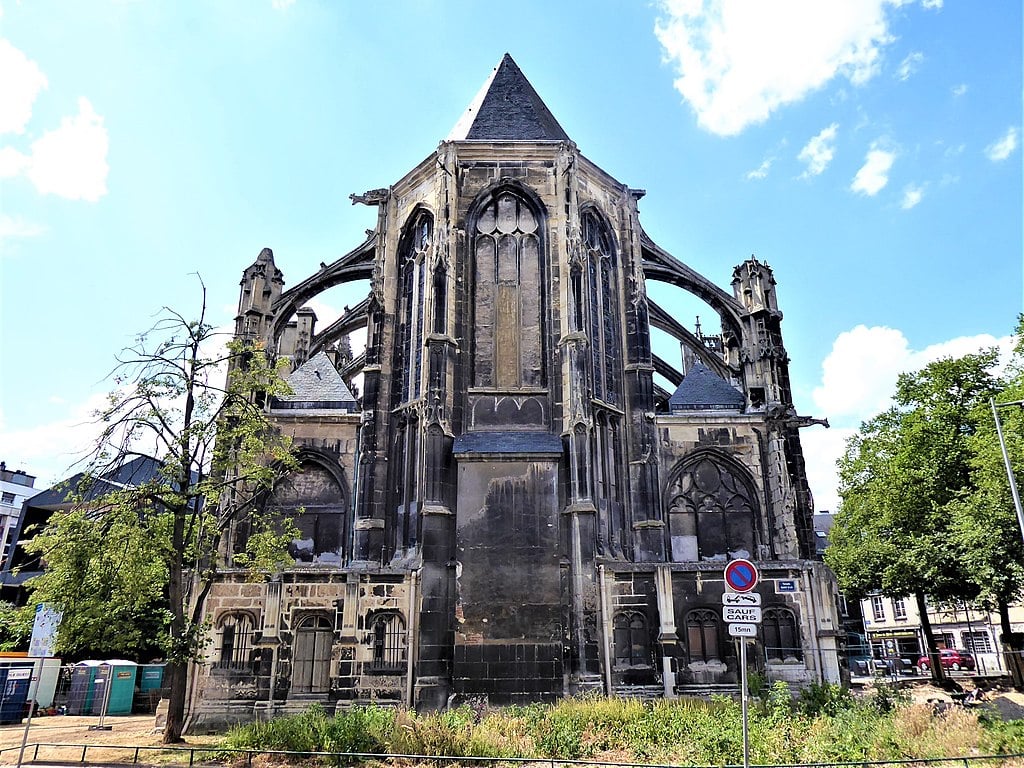
St-Eloi had to suffer some damage during the Second World War and was not returned to worship until April 2, 1950, after a serious restoration. The organ of the church is a Classified Historical monument and you can tour the church free of charge.
The House of the Exchequer (Bureau des Finances)
The House of the Exchequer (Bureau des Finances) across from the Rouen Cathedral is where you will find the Tourist Office of Rouen. Built between 1509 and 1540, the Gothic house also features early Renaissance elements, which makes it Rouen’s oldest Renaissance building.
It was here that Claude Monet painted 11 of his Rouen Cathedrals in the 1890s.
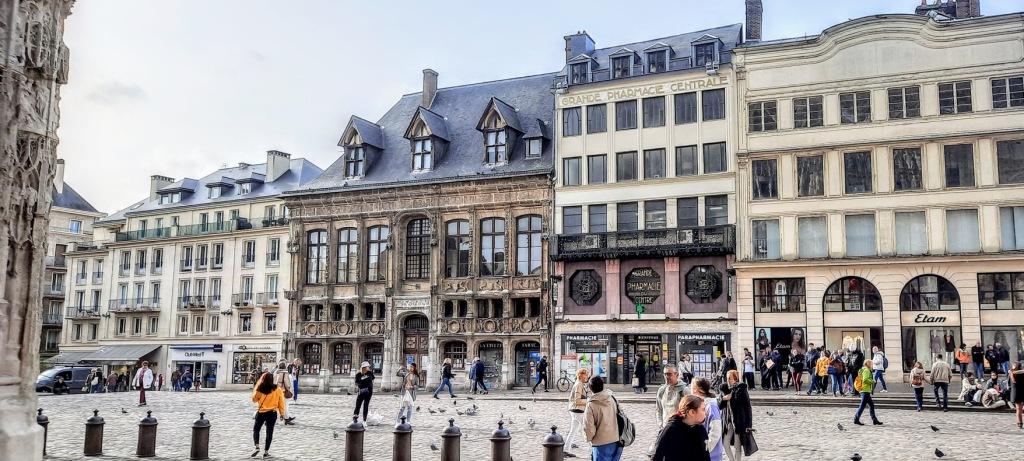
Musée des Beaux-Arts de Rouen
The Fine Arts Museum is one of the finest in France and was established by Napoléon Bonaparte in 1801 and is housed in a building designed by Louis Sauvageot and built between 1877 and 1888. The collections grew dramatically during the 19th century.
The collection increased from 300 pictures in 1823 to 600 “of the very highest merit” in 1878, in a museum now cited as “the most comprehensive in France after that of Paris”.
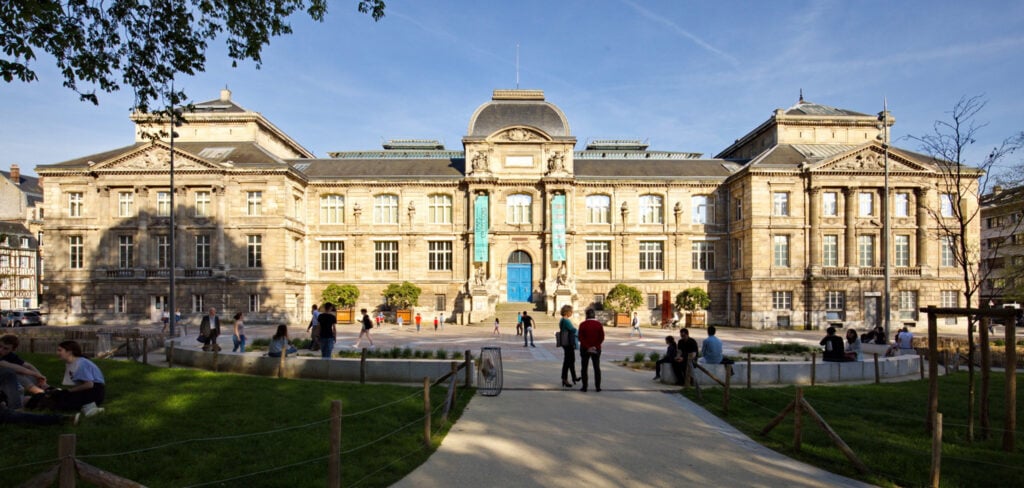
Musee Secq Des Tournelles
The Musée Le Secq des Tournelles is a museum devoted to the art of wrought ironwork and it is located in the late 15th-century church of Saint-Laurent. The idea for the collection came from Jean-Louis-Henri Le Secq Destournelles (1818-1882), a painter who studied in Paris and Rome, and became one of the first photographers in France. As such, he was commissioned by Prosper Mérimée to photograph various French monuments when the latter became head of the historical monument department in 1845.
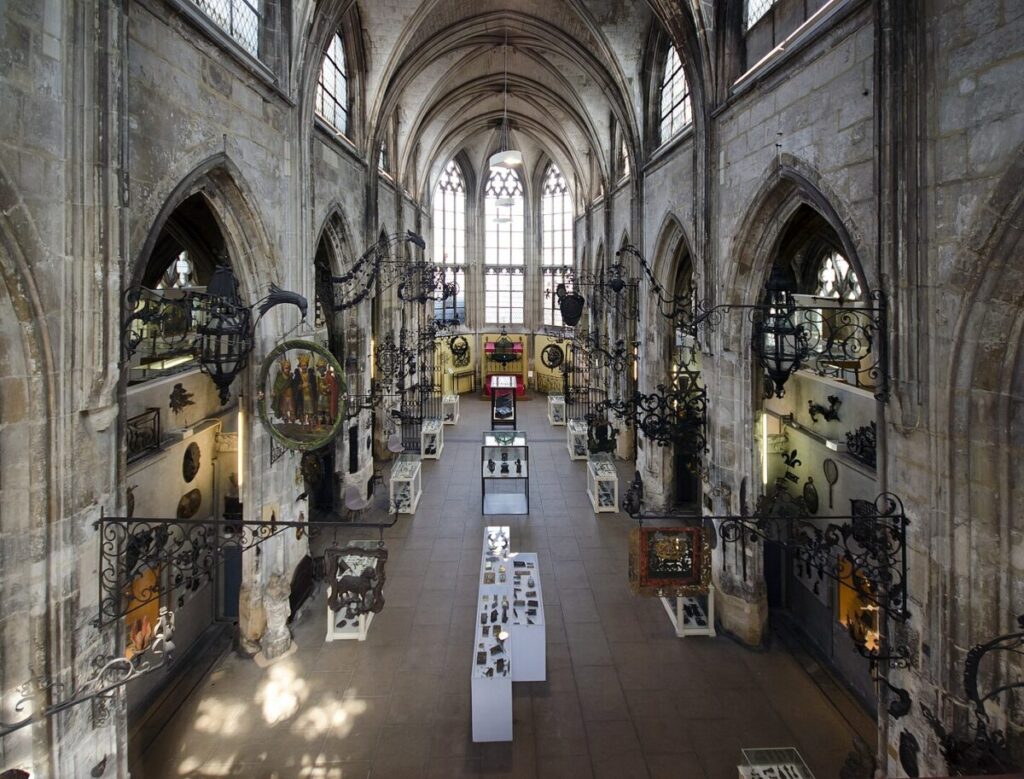
Gardens of Rouen
The centre of Rouen is mainly a pedestrian area and there are few parks and gardens within this area. We found a few gardens that were idyllic areas of peace and tranquillity within the city that charmed us, and around Rouen are several small gardens to visit.
The Albane Garden of the Cathedral
Adjoining the cathedral, this garden follows the lines of a cloister which would have been built in the 13th century. A carpet of boxwood and 16 Irish yews structure the space.
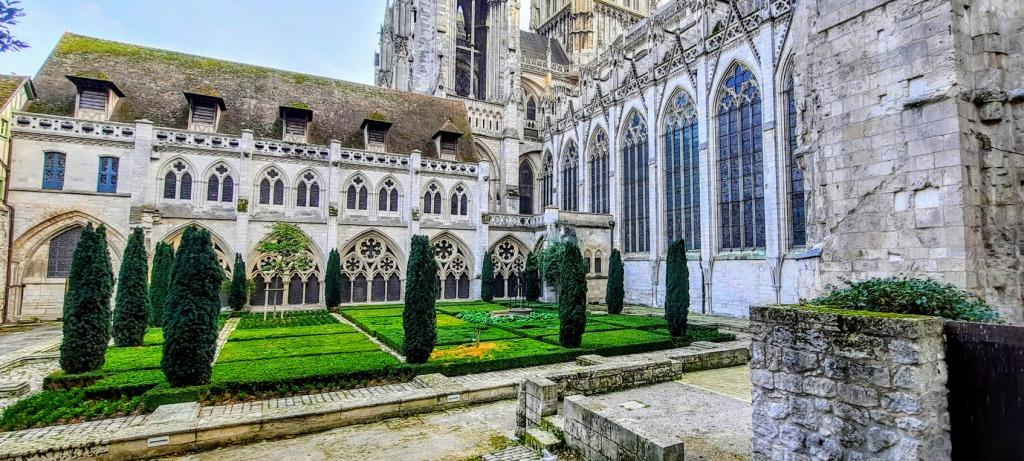
This green space is now known as Cour d’ Albane and was recently renovated. There are 7 historical themes, in small spaces around the green space. The courtyard of the sculptors, the porch of the 4 winds, the garden of the stonemason, the garden of the lime tree, the cat garden, the iron cross garden and the garden of the Saint Romain chapel.
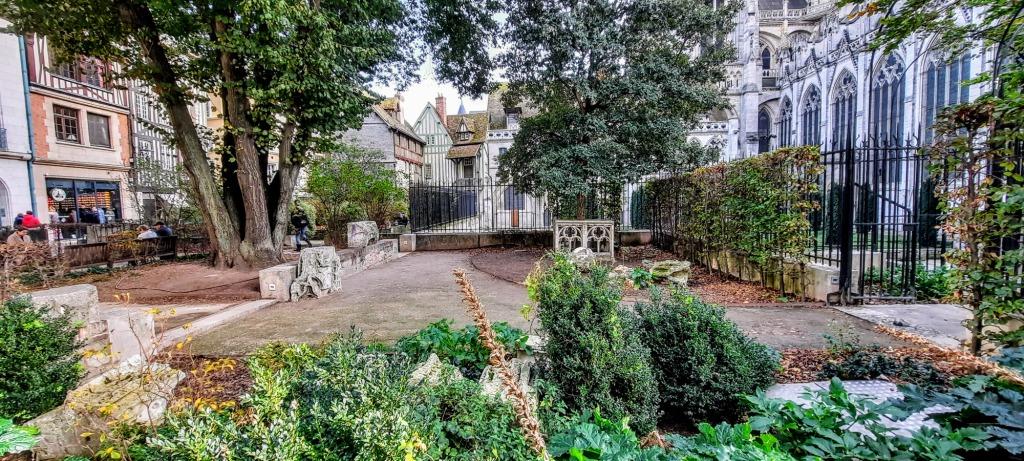
Architectural pieces from the renovation campaigns of the cathedral decorate the spaces.
Square Verdrel
Square Verdrel is a public garden located beside the Museum of Fine Arts. It was created in 1862 when the tanners district was razed. It is an English-style garden that contains 50 trees and 3000 shrubs and contains some of the most beautiful trees in Rouen.
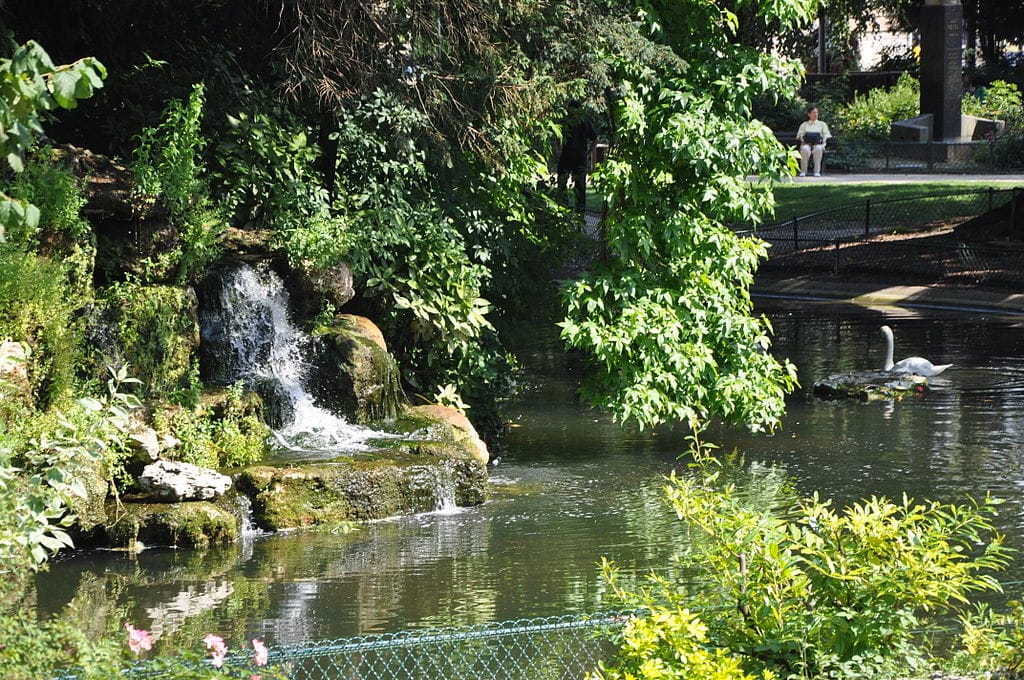
The Gardens of the City-Hall
The City Hall gardens (Jardins de l’Hôtel de Ville) can be found at the back of the City Hall and beside the Church of Saint Ouen. The gardens were part of the abbey of Saint-Ouen which disappeared during the French Revolution.
Created at the beginning of the 19th century on the land adjoining the Saint-Ouen abbey, the centre of the garden is a large round pool with a sculpture of the kidnapping of Dejanira by the Centaur Nessus.
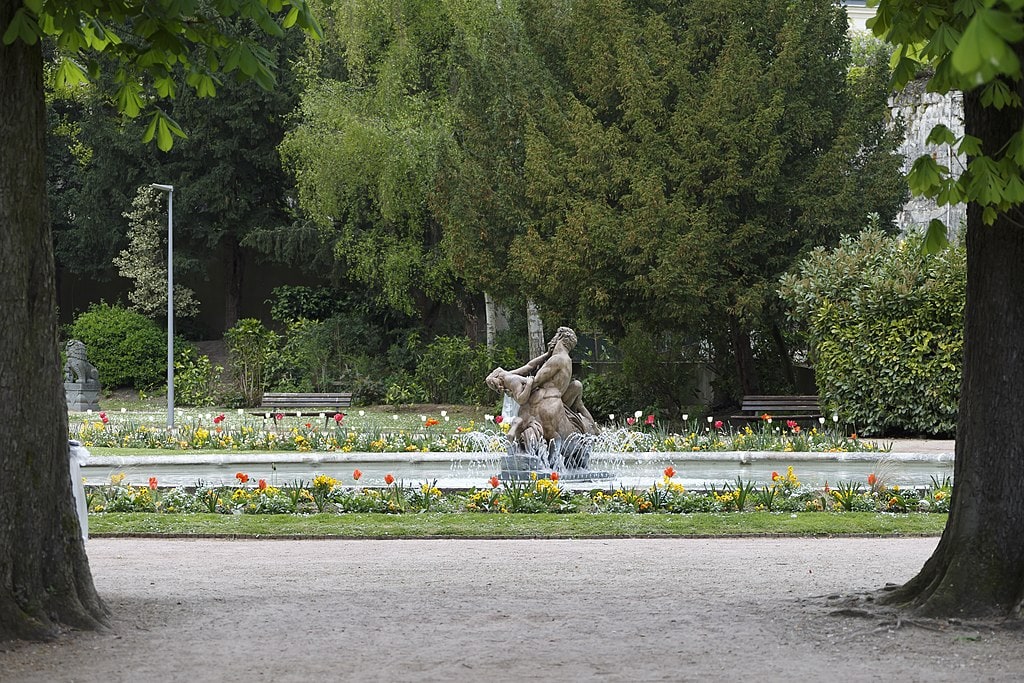
The remains of the abbey wall have been integrated into a “peat bog” and near the entrance, you can see a reproduction of the Jellinge stone in Denmark, a thousand years old, given to the City of Rouen on the occasion of the millennium of Normandy in 1911.
Jardin des Plantes
Rouen’s expansive green sanctuary, offers a tranquil respite just beyond the bustling city center. Spanning an impressive 85,000 square meters, this remarkable city garden showcases a diverse array of plant species sourced from around the globe. Visitors are treated to a visual feast year-round, with vibrant blooms adorning the gardens in every season. From enchanting wisteria that graces the landscape in spring to the splendid display of roses during the summer months, the Jardin des Plantes ensures a captivating botanical experience for all who wander through its gates.
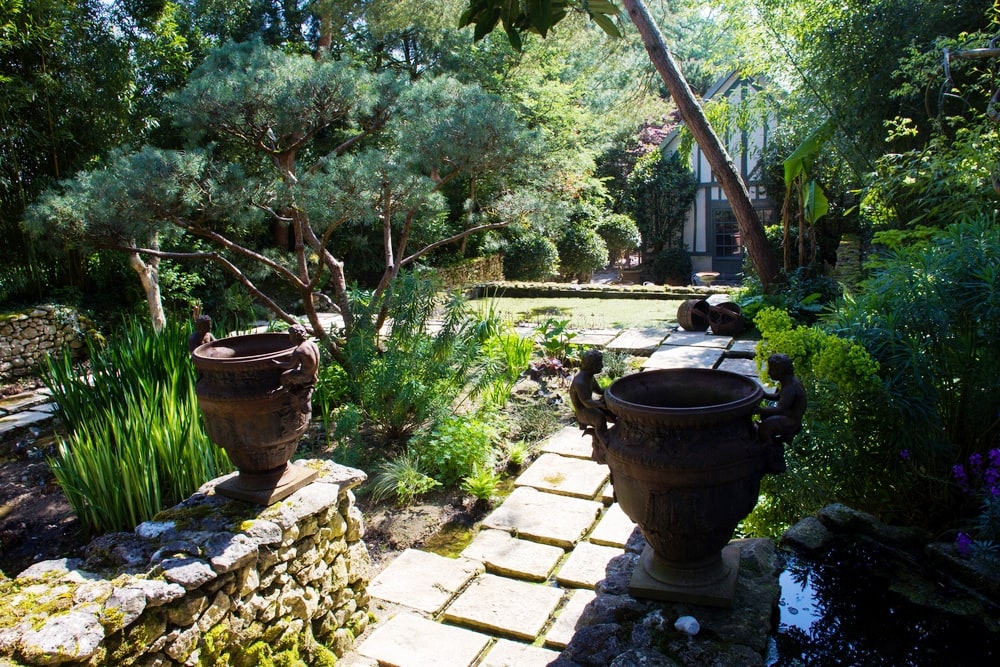
Musée de la céramique de Rouen – Ceramics Museum
Housed in the superb Hôtel d’Hocqueville a townhouse dating back to the 16th century the museum presents the most important pottery centres including Delft and Nevers but focuses on the Rouen production of tiles, earthenware and ceremonial ceramics from Rouen’s history of ceramic production.
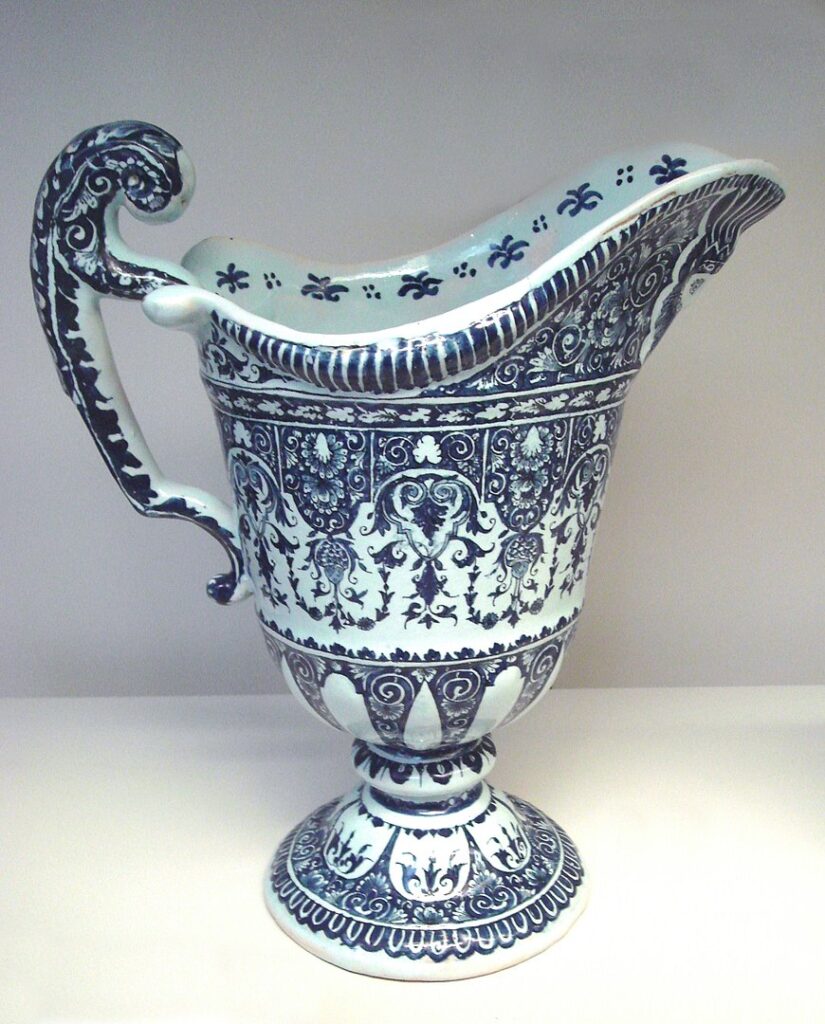
Where to stay in Rouen
Parking in Rouen
Be aware that parking in Rouen is very difficult as it is mainly a pedestrianised zone. To enter the main downtown area you will have to have a code to enter into the bollard which will be closing off the street. Our hotel provided us with this code but we had some difficulty figuring out how to use it.
With the bollard, there is a touch screen and you press where you see the instructions. The touch screen will change to a number pad where you can enter your code. The bollard light will change to green and the bollard itself will lower so you can enter the zone.
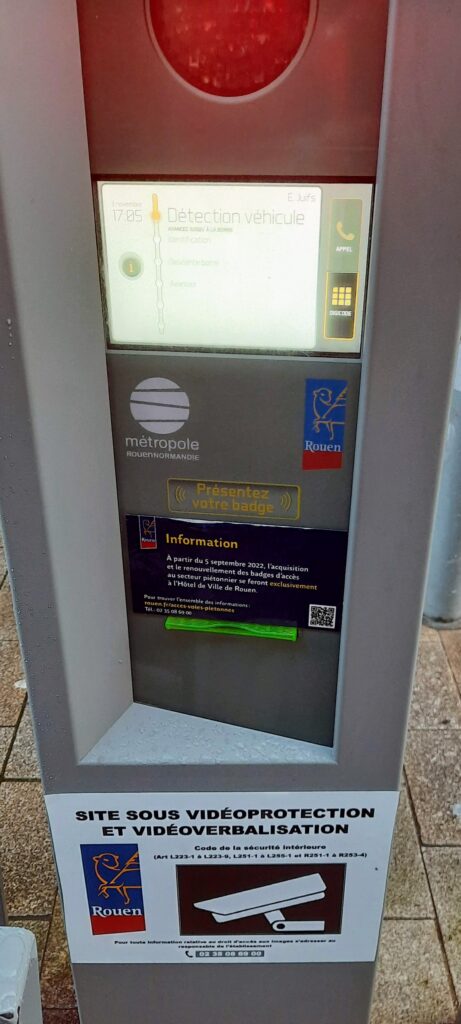
Parking usually costs around €15 euros per night.
Mercure Rouen Centre Cathedrale
Friends of ours recommended staying at the 4-star Mercure Rouen Centre Cathédrale and it was absolutely a fantastic recommendation. The hotel is located right beside the Rouen Cathedral and a better location for walking throughout Rouen to see all the possible sites couldn’t be found.
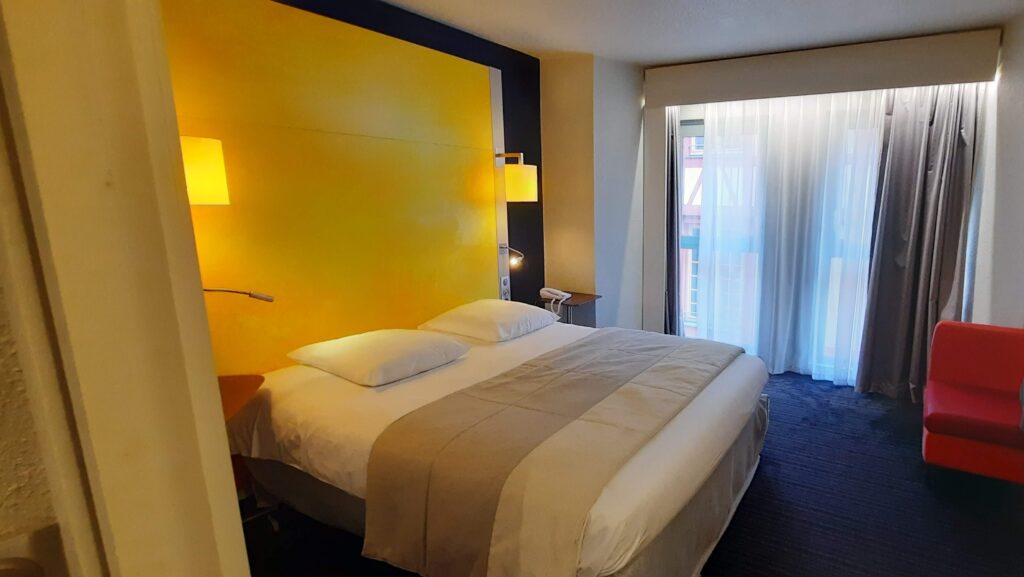
The price is extremely reasonable and there is parking underneath the hotel. The one thing I would say is that the beds are incredibly hard and the breakfast is expensive.
Hôtel de Bourgtheroulde, Autograph Collection
Another hotel which I would love to stay at is the 5 Star Hôtel de Bourgtheroulde, Autograph Collection. This is a simply stunning heritage building next to the Gros Horloge and guests can access valet parking and the indoor pool, fitness and spa centre including a sauna, hammam and a range of spa treatments.
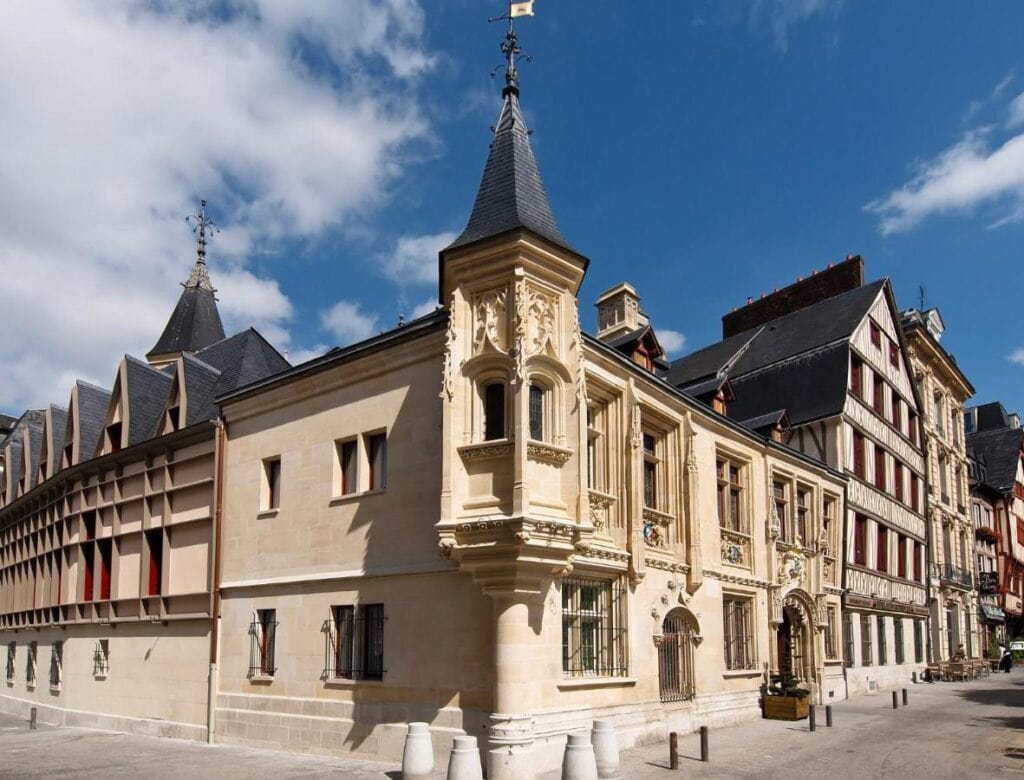
Where to eat in Rouen
Although France has a superb reputation for its gastronomy a lot of the time you are simply looking for some great food which is not to be found in many places here to be honest. However in Rouen, you are spoiled for choices from superb French food to Vietnamese, Thai, Sushi, Italian and that French favourite McDonald’s, and pizza.
A couple of things I would highly recommend are the traditional French croissant or Pain au Chocolat. We were very lucky with our hotel as we were right around the corner from a fabulous little bakery where we could get coffee and croissant and wonderful sandwiches for under €5 euros. The Boulangerie Fournil du Carre is a takeaway place with seating outside and the coffee is excellent.
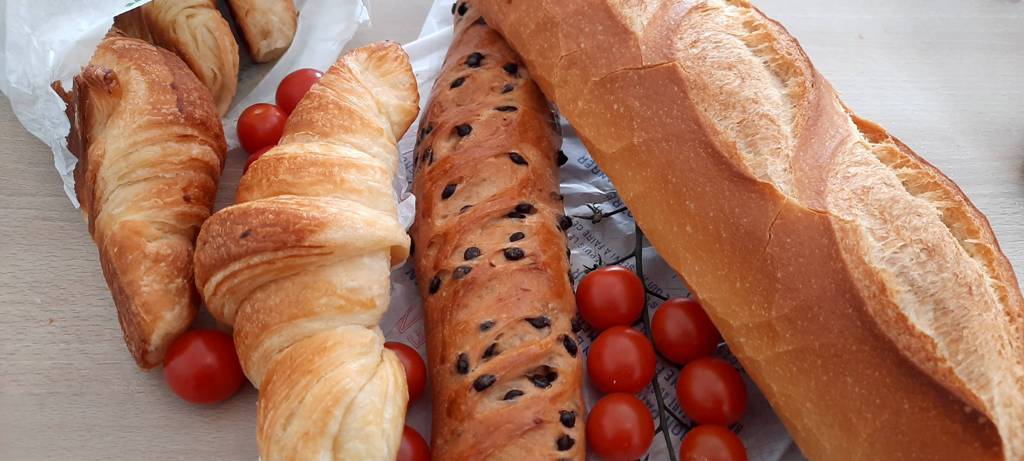
My other recommendation is to try the traditional Normandy Calvados or a Kir Normande which is a cocktail made from cider and mixed with Calvados, an apple brandy and Pommeau which is basically apple brandy mixed with apple juice and crème de cassis.
Best Restaurant in Rouen
La Couronne
Since 1345, the “La Couronne” on the Place du Vieux Marché in Rouen, is the scene of some of the best food in Rouen. La Couronne is best known as the restaurant where American TV chef Julia Child enjoyed her first meal in France—sole meunière—and was introduced to French cuisine.
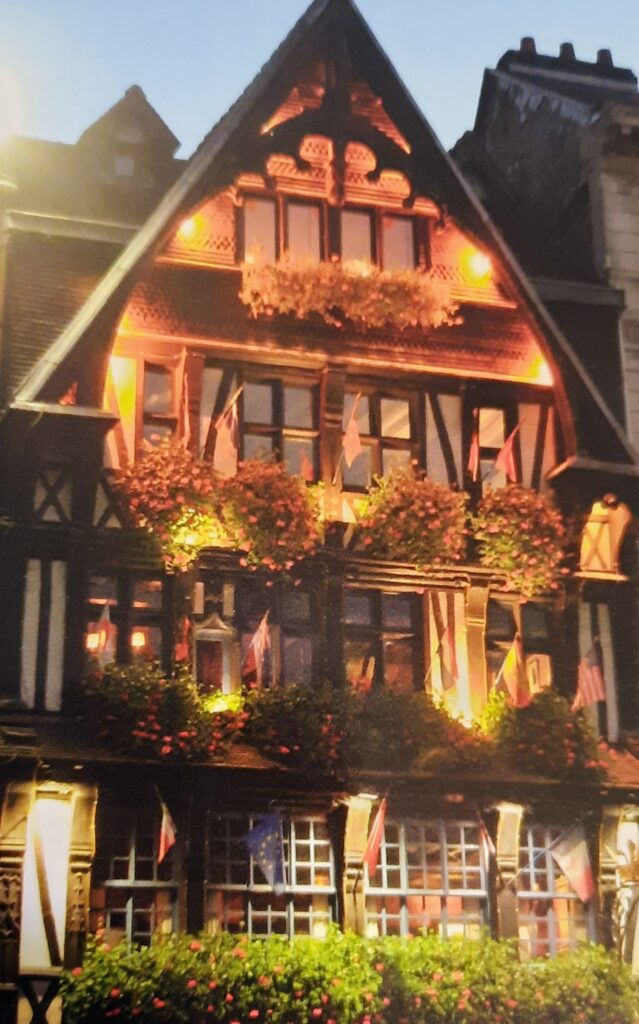
We had a superb 5-course meal from an amuse-bouche to fabulous desserts all served by staff with a brilliant sense of humour and no pretensions at all.
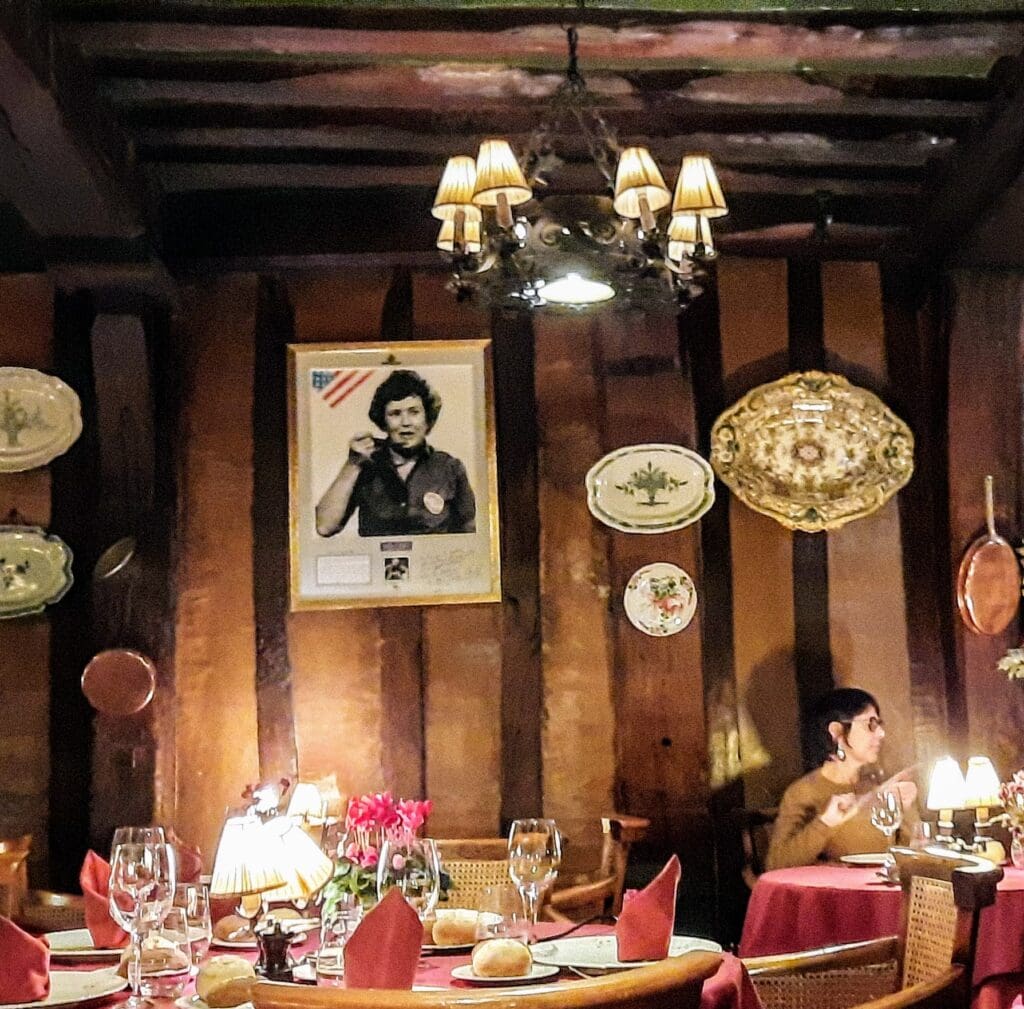
Bakin Donuts
We stumbled across this place Baking Donuts quite by accident, the owner was sampling his doughnuts on the rue d’Horloge and we were tempted. What we discovered was that rare thing an excellent French doughnut. Light and fluffy and topped with many different glazes and trimmings these were the best doughnuts we have found in France.
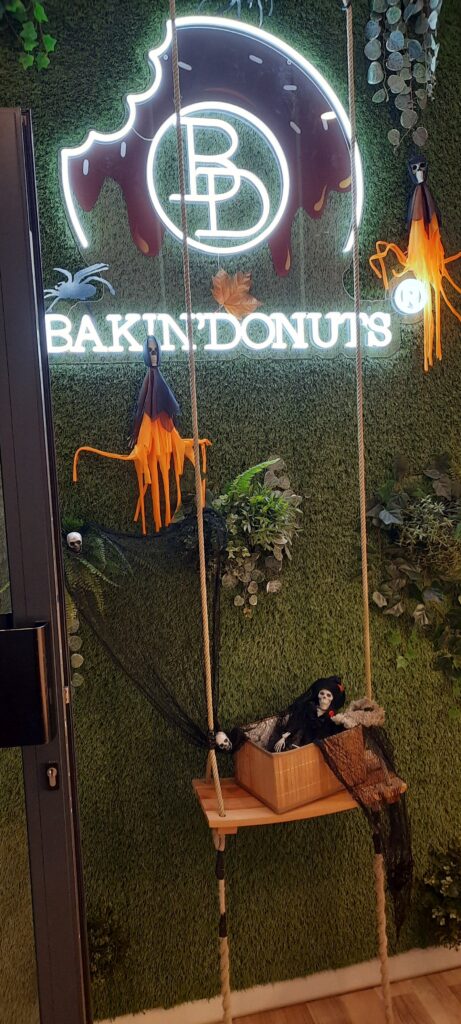
Sushi T-Em
A bubble tea and sushi takeaway where we had the freshest sushi and no cream cheese stuffed maki. Made to order this was a real treat for us as we missed our regular sushi joint in Canada every day. The shop is right across from Baking Donuts just off the rue d’Horloge.
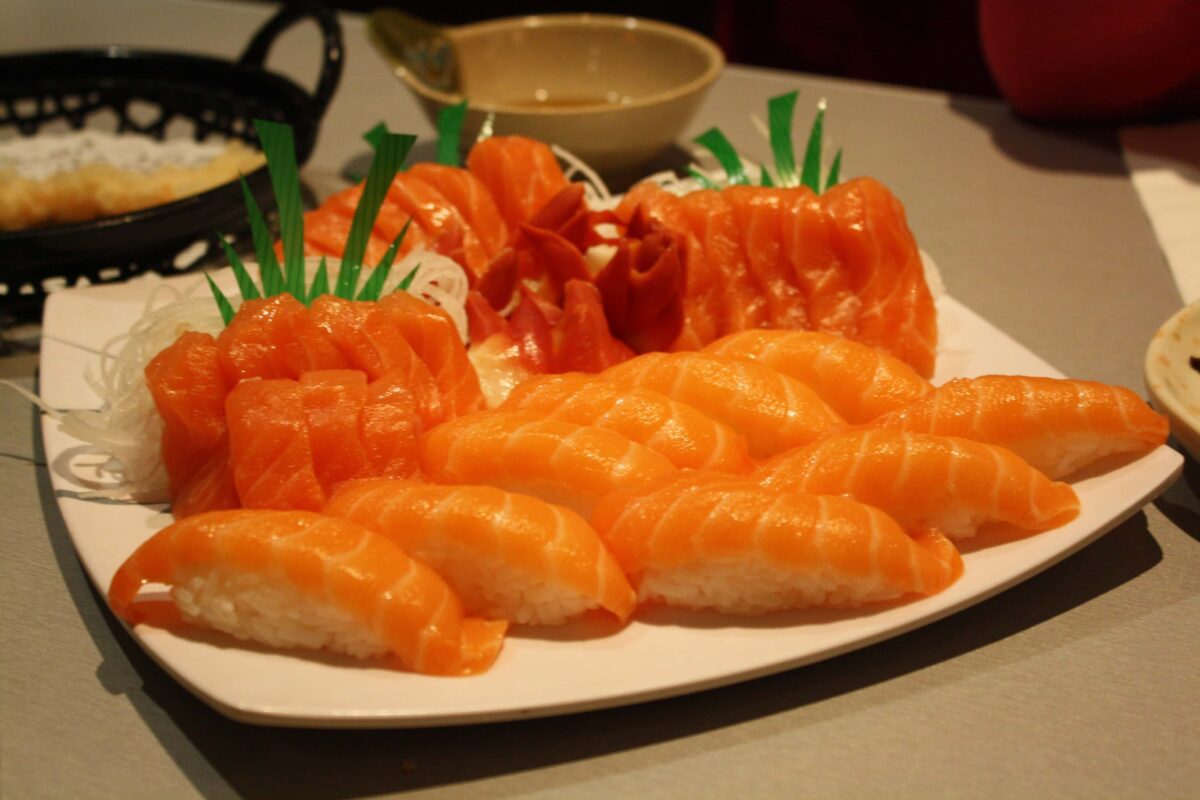
Free things to do in Rouen
What impressed us about Rouen is that visiting the stunning churches and cathedrals is always free. In England, you get stuck with massive ticket charges to visit some of the wonderful cathedrals in London.
Eight of Rouen’s prestigious museums now offer free entrance to its collections.
- The Museum of Fine Arts
- The Museum of Antiquities
The Museum of Ceramics
The Natural History Museum
The Museum Le Secq-de-Tournelles – Museum of Ironwork
Things to do around Rouen France
Given Rouen’s location, it makes a great place to explore areas of Normandy that you may otherwise miss. For example, it’s only an hour to drive to Giverny from Rouen where you can visit the glorious gardens of Monet. The pretty harbour of Honfleur, the white chalk cliffs of Étretat. For those of you with a need to see truly historic castles, you can visit Chateau Gaillard Richard the Lionheart’s medieval castle overlooking the charming town of Les Andelys on the banks of the River Seine. Just west of Rouen the River Seine meanders into the Parc Naturel régional des Boucles de la Seine Normande.
There’s also Chateau Harcourt built as a stone keep during the second half of the 12th century by Robert II d’Harcourt, a companion of Richard I of England “the Lionheart” during the Third Crusade. Versaille is also only 90 minutes away.
Rouen is a city to wander as there is so much to see and admire. Not to mention you can feed your Instagram account for days with your photos. So hopefully I answered any questions you may have about visiting Rouen and that you enjoy your stay as much as I did.
Take some time to explore France, here are some more articles to read.
Château de Josselin – A 1000 years of history in the heart of Brittany
One fabulous day in Menton France
Pros and Cons of Living in France
Normandy Villages 22 of the most beautiful
Saint-Céneri-le-Gérei plus beaux villages – beautiful villages of France
Sainte Suzanne – One of the “Most Beautiful Villages in France”
Food in Brittany: Fall in love with the food of Bretagne
Chinon – Fortress of the Plantagenets
Visiting Fougères France – City of Art and History
Domfront Normandy – royal power struggles
Pin it to save it
